
Working with ONNX models in float16 and float8 formats
Contents
- 1. New Data Types for Working with ONNX Models
- 1.1. FP16 format
- 1.1.1. Execution Tests of the ONNX Cast Operator for FLOAT16
- 1.1.2. Execution Tests of the ONNX Cast Operator for BFLOAT16
- 1.2. FP8 format
- 1.2.1. FP8 formats fp8_e5m2 and fp8_e4m3
- 1.2.2. Execution Tests of the ONNX Cast Operator for FLOAT8
- 2. Using ONNX for Image Super-Resolution
- 2.1. Executing ONNX Model with float32
- 2.2. Executing an ONNX Model with float16
- Conclusions
With the advancement of machine learning and artificial intelligence technologies, there is a growing need to optimize processes for working with models. The efficiency of model operation directly depends on the data formats used to represent them. In recent years, several new data types have emerged, specifically designed for working with deep learning models.
In this article, we will focus on two such new data formats - float16 and float8, which are beginning to be actively used in modern ONNX models. These formats represent alternative options to more precise but resource-intensive floating-point data formats. They provide an optimal balance between performance and accuracy, making them particularly attractive for various machine learning tasks. We will explore the key characteristics and advantages of float16 and float8 formats, as well as introduce functions for converting them to standard float and double formats.
This will help developers and researchers better understand how to effectively use these formats in their projects and models. As an example, we will examine the operation of the ESRGAN ONNX model, which is used for image quality enhancement.
1. New Data Types for Working with ONNX Models
To speed up computations, some models utilize data types with lower precision, such as Float16 and even Float8.
Support for these new data types has been added to work with ONNX models in the MQL5 language, allowing for the manipulation of 8-bit and 16-bit floating-point representations.
The script outputs the full list of elements of the ENUM_ONNX_DATA_TYPE enumeration.
//+------------------------------------------------------------------+ //| ONNX_Data_Types.mq5 | //| Copyright 2024, MetaQuotes Ltd. | //| https://www.mql5.com | //+------------------------------------------------------------------+ #property copyright "Copyright 2024, MetaQuotes Ltd." #property link "https://www.mql5.com" #property version "1.00" //+------------------------------------------------------------------+ //| Script program start function | //+------------------------------------------------------------------+ void OnStart() { //--- for(int i=0; i<21; i++) PrintFormat("%2d %s",i,EnumToString(ENUM_ONNX_DATA_TYPE(i))); }
Output:
0: ONNX_DATA_TYPE_UNDEFINED 1: ONNX_DATA_TYPE_FLOAT 2: ONNX_DATA_TYPE_UINT8 3: ONNX_DATA_TYPE_INT8 4: ONNX_DATA_TYPE_UINT16 5: ONNX_DATA_TYPE_INT16 6: ONNX_DATA_TYPE_INT32 7: ONNX_DATA_TYPE_INT64 8: ONNX_DATA_TYPE_STRING 9: ONNX_DATA_TYPE_BOOL 10: ONNX_DATA_TYPE_FLOAT16 11: ONNX_DATA_TYPE_DOUBLE 12: ONNX_DATA_TYPE_UINT32 13: ONNX_DATA_TYPE_UINT64 14: ONNX_DATA_TYPE_COMPLEX64 15: ONNX_DATA_TYPE_COMPLEX128 16: ONNX_DATA_TYPE_BFLOAT16 17: ONNX_DATA_TYPE_FLOAT8E4M3FN 18: ONNX_DATA_TYPE_FLOAT8E4M3FNUZ 19: ONNX_DATA_TYPE_FLOAT8E5M2 20: ONNX_DATA_TYPE_FLOAT8E5M2FNUZ
Thus, it is now possible to execute ONNX models working with such data.
Moreover, in MQL5, additional functions for data conversion have been added:
bool ArrayToFP16(ushort &dst_array[],const float &src_array[],ENUM_FLOAT16_FORMAT fmt); bool ArrayToFP16(ushort &dst_array[],const double &src_array[],ENUM_FLOAT16_FORMAT fmt); bool ArrayToFP8(uchar &dst_array[],const float &src_array[],ENUM_FLOAT8_FORMAT fmt); bool ArrayToFP8(uchar &dst_array[],const double &src_array[],ENUM_FLOAT8_FORMAT fmt); bool ArrayFromFP16(float &dst_array[],const ushort &src_array[],ENUM_FLOAT16_FORMAT fmt); bool ArrayFromFP16(double &dst_array[],const ushort &src_array[],ENUM_FLOAT16_FORMAT fmt); bool ArrayFromFP8(float &dst_array[],const uchar &src_array[],ENUM_FLOAT8_FORMAT fmt); bool ArrayFromFP8(double &dst_array[],const uchar &src_array[],ENUM_FLOAT8_FORMAT fmt);
Since the floating-point formats for 16 and 8 bits may differ, the 'fmt' parameter in the conversion functions must specify which format of number needs to be processed.
For 16-bit versions, a new ENUM_FLOAT16_FORMAT enumeration is used, which currently has the following values:
- FLOAT_FP16 — standard 16-bit format, also known as half float.
- FLOAT_BFP16 — special brain float point floating-point format.
- FLOAT_FP8_E4M3FN — 8-bit floating-point number, 4-bit exponent and 3-bit mantissa. Usually used as coefficients.
- FLOAT_FP8_E4M3FNUZ — 8-bit floating-point number, 4-bit exponent and 3-bit mantissa. Supports NaN, does not support negative zero and Inf. Usually used as coefficients.
- FLOAT_FP8_E5M2FN — 8-bit floating-point number, 5-bit exponent and 2-bit mantissa. Supports NaN and Inf. Usually used for gradients.
- FLOAT_FP8_E5M2FNUZ — 8-bit floating-point number, 5-bit exponent and 2-bit mantissa. Supports NaN and Inf, does not support negative zero. Also used for gradients.
1.1. FP16 Format
FLOAT16 and BFLOAT16 formats are data types used to represent floating-point numbers.
FLOAT16, also known as "half-precision floating point" format, uses 16 bits to represent a floating-point number. This format provides a balance between precision and computational efficiency. FLOAT16 is widely used in deep learning and neural networks, where high performance is required when processing large volumes of data. This format allows for accelerated computations by reducing the size of numbers, which is particularly important when training deep neural networks on graphics processing units (GPUs).
BFLOAT16 (or Brain Floating Point 16) also uses 16 bits, but it differs from FLOAT16 in the way numbers are represented. In this format, 8 bits are allocated for representing the exponent, and the remaining 7 bits are used to represent the mantissa. This format was developed for use in deep learning and artificial intelligence, especially in Google Tensor Processing Unit (TPU) processors. BFLOAT16 provides good performance when training neural networks and can be effectively used to accelerate computations.
Both of these formats have their advantages and limitations. FLOAT16 provides higher precision but requires more resources for storage and computations. BFLOAT16, on the other hand, provides higher performance and efficiency when processing data but may be less precise.
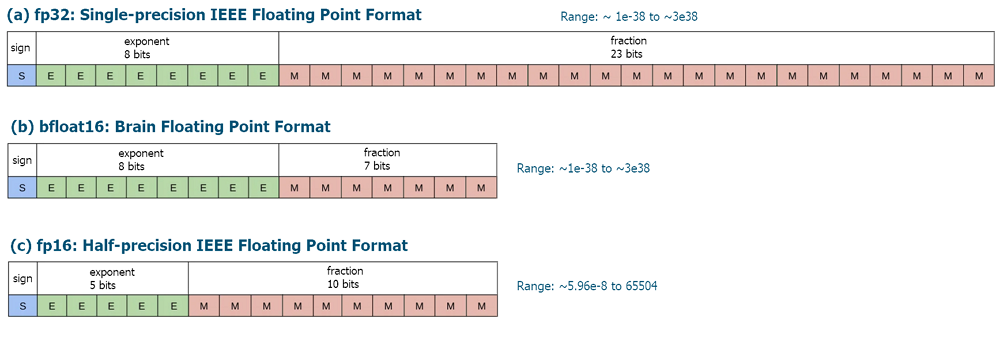
Fig.1. Formats of the bit representation of floating-point numbers FLOAT16 and BFLOAT16
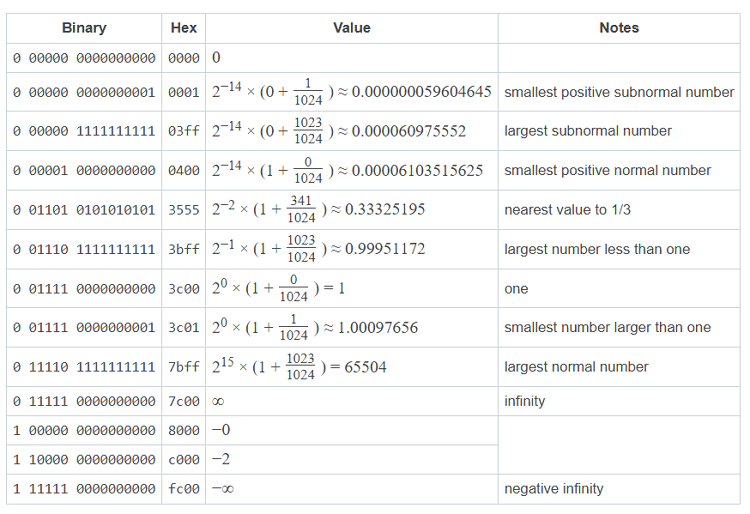
Table 1. Floating-point numbers in FLOAT16 format
1.1.1. Execution Tests of the ONNX Cast Operator for FLOAT16
As an illustration, let's consider the task of converting data of type FLOAT16 to types float and double.
ONNX models with the Cast operation:
- https://github.com/onnx/onnx/tree/main/onnx/backend/test/data/node/test_cast_FLOAT16_to_FLOAT
- https://github.com/onnx/onnx/tree/main/onnx/backend/test/data/node/test_cast_FLOAT16_to_DOUBLE
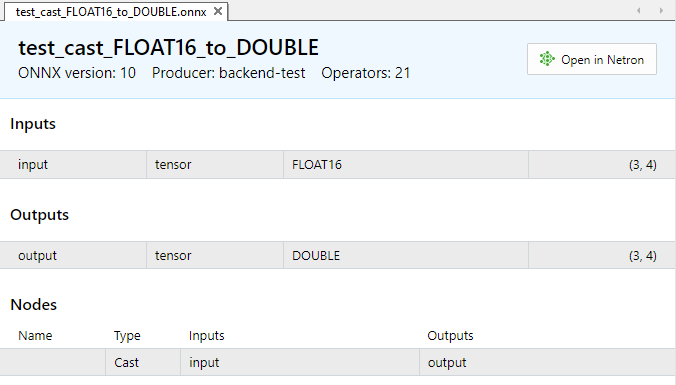
Fig.2. Input and output parameters of the model test_cast_FLOAT16_to_DOUBLE.onnx
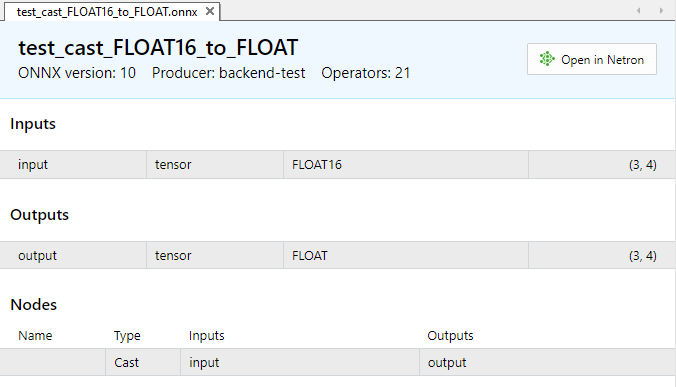
Fig.3. Input and output parameters of the model test_cast_FLOAT16_to_FLOAT.onnx
As seen from the description of the properties of ONNX models, the input requires data of type ONNX_DATA_TYPE_FLOAT16, and the model will return output data in the ONNX_DATA_TYPE_FLOAT format..
To convert the values, we will use the functions ArrayToFP16() and ArrayFromFP16() with the FLOAT_FP16 parameter.
Example:
//+------------------------------------------------------------------+ //| TestCastFloat16.mq5 | //| Copyright 2024, MetaQuotes Ltd. | //| https://www.mql5.com | //+------------------------------------------------------------------+ #property copyright "Copyright 2024, MetaQuotes Ltd." #property link "https://www.mql5.com" #property version "1.00" #resource "models\\test_cast_FLOAT16_to_DOUBLE.onnx" as const uchar ExtModel1[]; #resource "models\\test_cast_FLOAT16_to_FLOAT.onnx" as const uchar ExtModel2[]; //+------------------------------------------------------------------+ //| union for data conversion | //+------------------------------------------------------------------+ template<typename T> union U { uchar uc[sizeof(T)]; T value; }; //+------------------------------------------------------------------+ //| ArrayToString | //+------------------------------------------------------------------+ template<typename T> string ArrayToString(const T &data[],uint length=16) { string res; for(uint n=0; n<MathMin(length,data.Size()); n++) res+="," + StringFormat("%.2x",data[n]); StringSetCharacter(res,0,'['); return res+"]"; } //+------------------------------------------------------------------+ //| PatchONNXModel | //+------------------------------------------------------------------+ void PatchONNXModel(const uchar &original_model[],uchar &patched_model[]) { ArrayCopy(patched_model,original_model,0,0,WHOLE_ARRAY); //--- special ONNX model patch(IR=9,Opset=20) patched_model[1]=0x09; patched_model[ArraySize(patched_model)-1]=0x14; } //+------------------------------------------------------------------+ //| CreateModel | //+------------------------------------------------------------------+ bool CreateModel(long &model_handle,const uchar &model[]) { model_handle=INVALID_HANDLE; ulong flags=ONNX_DEFAULT; //ulong flags=ONNX_DEBUG_LOGS; //--- model_handle=OnnxCreateFromBuffer(model,flags); if(model_handle==INVALID_HANDLE) return(false); //--- return(true); } //+------------------------------------------------------------------+ //| PrepareShapes | //+------------------------------------------------------------------+ bool PrepareShapes(long model_handle) { ulong input_shape1[]= {3,4}; if(!OnnxSetInputShape(model_handle,0,input_shape1)) { PrintFormat("error in OnnxSetInputShape for input1. error code=%d",GetLastError()); //-- OnnxRelease(model_handle); return(false); } //--- ulong output_shape[]= {3,4}; if(!OnnxSetOutputShape(model_handle,0,output_shape)) { PrintFormat("error in OnnxSetOutputShape for output. error code=%d",GetLastError()); //-- OnnxRelease(model_handle); return(false); } //--- return(true); } //+------------------------------------------------------------------+ //| RunCastFloat16ToDouble | //+------------------------------------------------------------------+ bool RunCastFloat16ToDouble(long model_handle) { PrintFormat("test=%s",__FUNCTION__); double test_data[12]= {1,2,3,4,5,6,7,8,9,10,11,12}; ushort data_uint16[12]; if(!ArrayToFP16(data_uint16,test_data,FLOAT_FP16)) { Print("error in ArrayToFP16. error code=",GetLastError()); return(false); } Print("test array:"); ArrayPrint(test_data); Print("ArrayToFP16:"); ArrayPrint(data_uint16); U<ushort> input_float16_values[3*4]; U<double> output_double_values[3*4]; float test_data_float[]; if(!ArrayFromFP16(test_data_float,data_uint16,FLOAT_FP16)) { Print("error in ArrayFromFP16. error code=",GetLastError()); return(false); } for(int i=0; i<12; i++) { input_float16_values[i].value=data_uint16[i]; PrintFormat("%d input value =%f Hex float16 = %s ushort value=%d",i,test_data_float[i],ArrayToString(input_float16_values[i].uc),input_float16_values[i].value); } Print("ONNX input array:"); ArrayPrint(input_float16_values); bool res=OnnxRun(model_handle,ONNX_NO_CONVERSION,input_float16_values,output_double_values); if(!res) { PrintFormat("error in OnnxRun. error code=%d",GetLastError()); return(false); } Print("ONNX output array:"); ArrayPrint(output_double_values); //--- double sum_error=0.0; for(int i=0; i<12; i++) { double delta=test_data[i]-output_double_values[i].value; sum_error+=MathAbs(delta); PrintFormat("%d output double %f = %s difference=%f",i,output_double_values[i].value,ArrayToString(output_double_values[i].uc),delta); } //--- PrintFormat("test=%s sum_error=%f",__FUNCTION__,sum_error); //--- return(true); } //+------------------------------------------------------------------+ //| RunCastFloat16ToFloat | //+------------------------------------------------------------------+ bool RunCastFloat16ToFloat(long model_handle) { PrintFormat("test=%s",__FUNCTION__); double test_data[12]= {1,2,3,4,5,6,7,8,9,10,11,12}; ushort data_uint16[12]; if(!ArrayToFP16(data_uint16,test_data,FLOAT_FP16)) { Print("error in ArrayToFP16. error code=",GetLastError()); return(false); } Print("test array:"); ArrayPrint(test_data); Print("ArrayToFP16:"); ArrayPrint(data_uint16); U<ushort> input_float16_values[3*4]; U<float> output_float_values[3*4]; float test_data_float[]; if(!ArrayFromFP16(test_data_float,data_uint16,FLOAT_FP16)) { Print("error in ArrayFromFP16. error code=",GetLastError()); return(false); } for(int i=0; i<12; i++) { input_float16_values[i].value=data_uint16[i]; PrintFormat("%d input value =%f Hex float16 = %s ushort value=%d",i,test_data_float[i],ArrayToString(input_float16_values[i].uc),input_float16_values[i].value); } Print("ONNX input array:"); ArrayPrint(input_float16_values); bool res=OnnxRun(model_handle,ONNX_NO_CONVERSION,input_float16_values,output_float_values); if(!res) { PrintFormat("error in OnnxRun. error code=%d",GetLastError()); return(false); } Print("ONNX output array:"); ArrayPrint(output_float_values); //--- double sum_error=0.0; for(int i=0; i<12; i++) { double delta=test_data[i]-(double)output_float_values[i].value; sum_error+=MathAbs(delta); PrintFormat("%d output float %f = %s difference=%f",i,output_float_values[i].value,ArrayToString(output_float_values[i].uc),delta); } //--- PrintFormat("test=%s sum_error=%f",__FUNCTION__,sum_error); //--- return(true); } //+------------------------------------------------------------------+ //| TestCastFloat16ToFloat | //+------------------------------------------------------------------+ bool TestCastFloat16ToFloat(const uchar &res_model[]) { uchar model[]; PatchONNXModel(res_model,model); //--- get model handle long model_handle=INVALID_HANDLE; //--- get model handle if(!CreateModel(model_handle,model)) return(false); //--- prepare input and output shapes if(!PrepareShapes(model_handle)) return(false); //--- run ONNX model if(!RunCastFloat16ToFloat(model_handle)) return(false); //--- release model handle OnnxRelease(model_handle); //--- return(true); } //+------------------------------------------------------------------+ //| TestCastFloat16ToDouble | //+------------------------------------------------------------------+ bool TestCastFloat16ToDouble(const uchar &res_model[]) { uchar model[]; PatchONNXModel(res_model,model); //--- long model_handle=INVALID_HANDLE; //--- get model handle if(!CreateModel(model_handle,model)) return(false); //--- prepare input and output shapes if(!PrepareShapes(model_handle)) return(false); //--- run ONNX model if(!RunCastFloat16ToDouble(model_handle)) return(false); //--- release model handle OnnxRelease(model_handle); //--- return(true); } //+------------------------------------------------------------------+ //| Script program start function | //+------------------------------------------------------------------+ int OnStart(void) { if(!TestCastFloat16ToDouble(ExtModel1)) return 1; if(!TestCastFloat16ToFloat(ExtModel2)) return 1; //--- return 0; } //+------------------------------------------------------------------+
Output:
TestCastFloat16 (EURUSD,H1) test=RunCastFloat16ToDouble TestCastFloat16 (EURUSD,H1) test array: TestCastFloat16 (EURUSD,H1) 1.00000 2.00000 3.00000 4.00000 5.00000 6.00000 7.00000 8.00000 9.00000 10.00000 11.00000 12.00000 TestCastFloat16 (EURUSD,H1) ArrayToFP16: TestCastFloat16 (EURUSD,H1) 15360 16384 16896 17408 17664 17920 18176 18432 18560 18688 18816 18944 TestCastFloat16 (EURUSD,H1) 0 input value =1.000000 Hex float16 = [00,3c] ushort value=15360 TestCastFloat16 (EURUSD,H1) 1 input value =2.000000 Hex float16 = [00,40] ushort value=16384 TestCastFloat16 (EURUSD,H1) 2 input value =3.000000 Hex float16 = [00,42] ushort value=16896 TestCastFloat16 (EURUSD,H1) 3 input value =4.000000 Hex float16 = [00,44] ushort value=17408 TestCastFloat16 (EURUSD,H1) 4 input value =5.000000 Hex float16 = [00,45] ushort value=17664 TestCastFloat16 (EURUSD,H1) 5 input value =6.000000 Hex float16 = [00,46] ushort value=17920 TestCastFloat16 (EURUSD,H1) 6 input value =7.000000 Hex float16 = [00,47] ushort value=18176 TestCastFloat16 (EURUSD,H1) 7 input value =8.000000 Hex float16 = [00,48] ushort value=18432 TestCastFloat16 (EURUSD,H1) 8 input value =9.000000 Hex float16 = [80,48] ushort value=18560 TestCastFloat16 (EURUSD,H1) 9 input value =10.000000 Hex float16 = [00,49] ushort value=18688 TestCastFloat16 (EURUSD,H1) 10 input value =11.000000 Hex float16 = [80,49] ushort value=18816 TestCastFloat16 (EURUSD,H1) 11 input value =12.000000 Hex float16 = [00,4a] ushort value=18944 TestCastFloat16 (EURUSD,H1) ONNX input array: TestCastFloat16 (EURUSD,H1) [uc] [value] TestCastFloat16 (EURUSD,H1) [ 0] ... 15360 TestCastFloat16 (EURUSD,H1) [ 1] ... 16384 TestCastFloat16 (EURUSD,H1) [ 2] ... 16896 TestCastFloat16 (EURUSD,H1) [ 3] ... 17408 TestCastFloat16 (EURUSD,H1) [ 4] ... 17664 TestCastFloat16 (EURUSD,H1) [ 5] ... 17920 TestCastFloat16 (EURUSD,H1) [ 6] ... 18176 TestCastFloat16 (EURUSD,H1) [ 7] ... 18432 TestCastFloat16 (EURUSD,H1) [ 8] ... 18560 TestCastFloat16 (EURUSD,H1) [ 9] ... 18688 TestCastFloat16 (EURUSD,H1) [10] ... 18816 TestCastFloat16 (EURUSD,H1) [11] ... 18944 TestCastFloat16 (EURUSD,H1) ONNX output array: TestCastFloat16 (EURUSD,H1) [uc] [value] TestCastFloat16 (EURUSD,H1) [ 0] ... 1.00000 TestCastFloat16 (EURUSD,H1) [ 1] ... 2.00000 TestCastFloat16 (EURUSD,H1) [ 2] ... 3.00000 TestCastFloat16 (EURUSD,H1) [ 3] ... 4.00000 TestCastFloat16 (EURUSD,H1) [ 4] ... 5.00000 TestCastFloat16 (EURUSD,H1) [ 5] ... 6.00000 TestCastFloat16 (EURUSD,H1) [ 6] ... 7.00000 TestCastFloat16 (EURUSD,H1) [ 7] ... 8.00000 TestCastFloat16 (EURUSD,H1) [ 8] ... 9.00000 TestCastFloat16 (EURUSD,H1) [ 9] ... 10.00000 TestCastFloat16 (EURUSD,H1) [10] ... 11.00000 TestCastFloat16 (EURUSD,H1) [11] ... 12.00000 TestCastFloat16 (EURUSD,H1) 0 output double 1.000000 = [00,00,00,00,00,00,f0,3f] difference=0.000000 TestCastFloat16 (EURUSD,H1) 1 output double 2.000000 = [00,00,00,00,00,00,00,40] difference=0.000000 TestCastFloat16 (EURUSD,H1) 2 output double 3.000000 = [00,00,00,00,00,00,08,40] difference=0.000000 TestCastFloat16 (EURUSD,H1) 3 output double 4.000000 = [00,00,00,00,00,00,10,40] difference=0.000000 TestCastFloat16 (EURUSD,H1) 4 output double 5.000000 = [00,00,00,00,00,00,14,40] difference=0.000000 TestCastFloat16 (EURUSD,H1) 5 output double 6.000000 = [00,00,00,00,00,00,18,40] difference=0.000000 TestCastFloat16 (EURUSD,H1) 6 output double 7.000000 = [00,00,00,00,00,00,1c,40] difference=0.000000 TestCastFloat16 (EURUSD,H1) 7 output double 8.000000 = [00,00,00,00,00,00,20,40] difference=0.000000 TestCastFloat16 (EURUSD,H1) 8 output double 9.000000 = [00,00,00,00,00,00,22,40] difference=0.000000 TestCastFloat16 (EURUSD,H1) 9 output double 10.000000 = [00,00,00,00,00,00,24,40] difference=0.000000 TestCastFloat16 (EURUSD,H1) 10 output double 11.000000 = [00,00,00,00,00,00,26,40] difference=0.000000 TestCastFloat16 (EURUSD,H1) 11 output double 12.000000 = [00,00,00,00,00,00,28,40] difference=0.000000 TestCastFloat16 (EURUSD,H1) test=RunCastFloat16ToDouble sum_error=0.000000 TestCastFloat16 (EURUSD,H1) test=RunCastFloat16ToFloat TestCastFloat16 (EURUSD,H1) test array: TestCastFloat16 (EURUSD,H1) 1.00000 2.00000 3.00000 4.00000 5.00000 6.00000 7.00000 8.00000 9.00000 10.00000 11.00000 12.00000 TestCastFloat16 (EURUSD,H1) ArrayToFP16: TestCastFloat16 (EURUSD,H1) 15360 16384 16896 17408 17664 17920 18176 18432 18560 18688 18816 18944 TestCastFloat16 (EURUSD,H1) 0 input value =1.000000 Hex float16 = [00,3c] ushort value=15360 TestCastFloat16 (EURUSD,H1) 1 input value =2.000000 Hex float16 = [00,40] ushort value=16384 TestCastFloat16 (EURUSD,H1) 2 input value =3.000000 Hex float16 = [00,42] ushort value=16896 TestCastFloat16 (EURUSD,H1) 3 input value =4.000000 Hex float16 = [00,44] ushort value=17408 TestCastFloat16 (EURUSD,H1) 4 input value =5.000000 Hex float16 = [00,45] ushort value=17664 TestCastFloat16 (EURUSD,H1) 5 input value =6.000000 Hex float16 = [00,46] ushort value=17920 TestCastFloat16 (EURUSD,H1) 6 input value =7.000000 Hex float16 = [00,47] ushort value=18176 TestCastFloat16 (EURUSD,H1) 7 input value =8.000000 Hex float16 = [00,48] ushort value=18432 TestCastFloat16 (EURUSD,H1) 8 input value =9.000000 Hex float16 = [80,48] ushort value=18560 TestCastFloat16 (EURUSD,H1) 9 input value =10.000000 Hex float16 = [00,49] ushort value=18688 TestCastFloat16 (EURUSD,H1) 10 input value =11.000000 Hex float16 = [80,49] ushort value=18816 TestCastFloat16 (EURUSD,H1) 11 input value =12.000000 Hex float16 = [00,4a] ushort value=18944 TestCastFloat16 (EURUSD,H1) ONNX input array: TestCastFloat16 (EURUSD,H1) [uc] [value] TestCastFloat16 (EURUSD,H1) [ 0] ... 15360 TestCastFloat16 (EURUSD,H1) [ 1] ... 16384 TestCastFloat16 (EURUSD,H1) [ 2] ... 16896 TestCastFloat16 (EURUSD,H1) [ 3] ... 17408 TestCastFloat16 (EURUSD,H1) [ 4] ... 17664 TestCastFloat16 (EURUSD,H1) [ 5] ... 17920 TestCastFloat16 (EURUSD,H1) [ 6] ... 18176 TestCastFloat16 (EURUSD,H1) [ 7] ... 18432 TestCastFloat16 (EURUSD,H1) [ 8] ... 18560 TestCastFloat16 (EURUSD,H1) [ 9] ... 18688 TestCastFloat16 (EURUSD,H1) [10] ... 18816 TestCastFloat16 (EURUSD,H1) [11] ... 18944 TestCastFloat16 (EURUSD,H1) ONNX output array: TestCastFloat16 (EURUSD,H1) [uc] [value] TestCastFloat16 (EURUSD,H1) [ 0] ... 1.00000 TestCastFloat16 (EURUSD,H1) [ 1] ... 2.00000 TestCastFloat16 (EURUSD,H1) [ 2] ... 3.00000 TestCastFloat16 (EURUSD,H1) [ 3] ... 4.00000 TestCastFloat16 (EURUSD,H1) [ 4] ... 5.00000 TestCastFloat16 (EURUSD,H1) [ 5] ... 6.00000 TestCastFloat16 (EURUSD,H1) [ 6] ... 7.00000 TestCastFloat16 (EURUSD,H1) [ 7] ... 8.00000 TestCastFloat16 (EURUSD,H1) [ 8] ... 9.00000 TestCastFloat16 (EURUSD,H1) [ 9] ... 10.00000 TestCastFloat16 (EURUSD,H1) [10] ... 11.00000 TestCastFloat16 (EURUSD,H1) [11] ... 12.00000 TestCastFloat16 (EURUSD,H1) 0 output float 1.000000 = [00,00,80,3f] difference=0.000000 TestCastFloat16 (EURUSD,H1) 1 output float 2.000000 = [00,00,00,40] difference=0.000000 TestCastFloat16 (EURUSD,H1) 2 output float 3.000000 = [00,00,40,40] difference=0.000000 TestCastFloat16 (EURUSD,H1) 3 output float 4.000000 = [00,00,80,40] difference=0.000000 TestCastFloat16 (EURUSD,H1) 4 output float 5.000000 = [00,00,a0,40] difference=0.000000 TestCastFloat16 (EURUSD,H1) 5 output float 6.000000 = [00,00,c0,40] difference=0.000000 TestCastFloat16 (EURUSD,H1) 6 output float 7.000000 = [00,00,e0,40] difference=0.000000 TestCastFloat16 (EURUSD,H1) 7 output float 8.000000 = [00,00,00,41] difference=0.000000 TestCastFloat16 (EURUSD,H1) 8 output float 9.000000 = [00,00,10,41] difference=0.000000 TestCastFloat16 (EURUSD,H1) 9 output float 10.000000 = [00,00,20,41] difference=0.000000 TestCastFloat16 (EURUSD,H1) 10 output float 11.000000 = [00,00,30,41] difference=0.000000 TestCastFloat16 (EURUSD,H1) 11 output float 12.000000 = [00,00,40,41] difference=0.000000 TestCastFloat16 (EURUSD,H1) test=RunCastFloat16ToFloat sum_error=0.000000
1.1.2. Execution Tests of the ONNX Cast Operator for BFLOAT16
This example examines the conversion from BFLOAT16 to float.
ONNX model with the Cast operation:
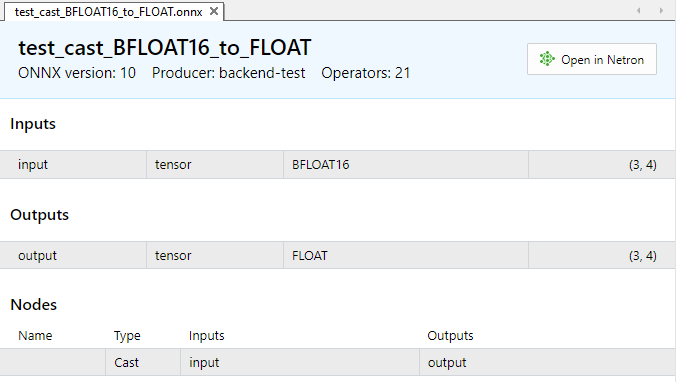
Fig.4. Input and output parameters of model test_cast_BFLOAT16_to_FLOAT.onnx
Input data of type ONNX_DATA_TYPE_BFLOAT16 is required, and the model will return output data in the format of ONNX_DATA_TYPE_FLOAT.
To convert the values, we will use the functions ArrayToFP16() and ArrayFromFP16() with the parameter BFLOAT_FP16.
//+------------------------------------------------------------------+ //| TestCastBFloat16.mq5 | //| Copyright 2024, MetaQuotes Ltd. | //| https://www.mql5.com | //+------------------------------------------------------------------+ #property copyright "Copyright 2024, MetaQuotes Ltd." #property link "https://www.mql5.com" #property version "1.00" #resource "models\\test_cast_BFLOAT16_to_FLOAT.onnx" as const uchar ExtModel1[]; //+------------------------------------------------------------------+ //| union for data conversion | //+------------------------------------------------------------------+ template<typename T> union U { uchar uc[sizeof(T)]; T value; }; //+------------------------------------------------------------------+ //| ArrayToString | //+------------------------------------------------------------------+ template<typename T> string ArrayToString(const T &data[],uint length=16) { string res; for(uint n=0; n<MathMin(length,data.Size()); n++) res+="," + StringFormat("%.2x",data[n]); StringSetCharacter(res,0,'['); return res+"]"; } //+------------------------------------------------------------------+ //| PatchONNXModel | //+------------------------------------------------------------------+ void PatchONNXModel(const uchar &original_model[],uchar &patched_model[]) { ArrayCopy(patched_model,original_model,0,0,WHOLE_ARRAY); //--- special ONNX model patch(IR=9,Opset=20) patched_model[1]=0x09; patched_model[ArraySize(patched_model)-1]=0x14; } //+------------------------------------------------------------------+ //| CreateModel | //+------------------------------------------------------------------+ bool CreateModel(long &model_handle,const uchar &model[]) { model_handle=INVALID_HANDLE; ulong flags=ONNX_DEFAULT; //ulong flags=ONNX_DEBUG_LOGS; //--- model_handle=OnnxCreateFromBuffer(model,flags); if(model_handle==INVALID_HANDLE) return(false); //--- return(true); } //+------------------------------------------------------------------+ //| PrepareShapes | //+------------------------------------------------------------------+ bool PrepareShapes(long model_handle) { ulong input_shape1[]= {3,4}; if(!OnnxSetInputShape(model_handle,0,input_shape1)) { PrintFormat("error in OnnxSetInputShape for input1. error code=%d",GetLastError()); //-- OnnxRelease(model_handle); return(false); } //--- ulong output_shape[]= {3,4}; if(!OnnxSetOutputShape(model_handle,0,output_shape)) { PrintFormat("error in OnnxSetOutputShape for output. error code=%d",GetLastError()); //-- OnnxRelease(model_handle); return(false); } //--- return(true); } //+------------------------------------------------------------------+ //| RunCastBFloat16ToFloat | //+------------------------------------------------------------------+ bool RunCastBFloat16ToFloat(long model_handle) { PrintFormat("test=%s",__FUNCTION__); double test_data[12]= {1,2,3,4,5,6,7,8,9,10,11,12}; ushort data_uint16[12]; if(!ArrayToFP16(data_uint16,test_data,FLOAT_BFP16)) { Print("error in ArrayToFP16. error code=",GetLastError()); return(false); } Print("test array:"); ArrayPrint(test_data); Print("ArrayToFP16:"); ArrayPrint(data_uint16); U<ushort> input_float16_values[3*4]; U<float> output_float_values[3*4]; float test_data_float[]; if(!ArrayFromFP16(test_data_float,data_uint16,FLOAT_BFP16)) { Print("error in ArrayFromFP16. error code=",GetLastError()); return(false); } for(int i=0; i<12; i++) { input_float16_values[i].value=data_uint16[i]; PrintFormat("%d input value =%f Hex float16 = %s ushort value=%d",i,test_data_float[i],ArrayToString(input_float16_values[i].uc),input_float16_values[i].value); } Print("ONNX input array:"); ArrayPrint(input_float16_values); bool res=OnnxRun(model_handle,ONNX_NO_CONVERSION,input_float16_values,output_float_values); if(!res) { PrintFormat("error in OnnxRun. error code=%d",GetLastError()); return(false); } Print("ONNX output array:"); ArrayPrint(output_float_values); //--- double sum_error=0.0; for(int i=0; i<12; i++) { double delta=test_data[i]-(double)output_float_values[i].value; sum_error+=MathAbs(delta); PrintFormat("%d output float %f = %s difference=%f",i,output_float_values[i].value,ArrayToString(output_float_values[i].uc),delta); } //--- PrintFormat("test=%s sum_error=%f",__FUNCTION__,sum_error); //--- return(true); } //+------------------------------------------------------------------+ //| Script program start function | //+------------------------------------------------------------------+ int OnStart(void) { uchar model[]; PatchONNXModel(ExtModel1,model); //--- get model handle long model_handle=INVALID_HANDLE; //--- get model handle if(!CreateModel(model_handle,model)) return 1; //--- prepare input and output shapes if(!PrepareShapes(model_handle)) return 1; //--- run ONNX model if(!RunCastBFloat16ToFloat(model_handle)) return 1; //--- release model handle OnnxRelease(model_handle); //--- return 0; } //+------------------------------------------------------------------+Output:
TestCastBFloat16 (EURUSD,H1) test=RunCastBFloat16ToFloat TestCastBFloat16 (EURUSD,H1) test array: TestCastBFloat16 (EURUSD,H1) 1.00000 2.00000 3.00000 4.00000 5.00000 6.00000 7.00000 8.00000 9.00000 10.00000 11.00000 12.00000 TestCastBFloat16 (EURUSD,H1) ArrayToFP16: TestCastBFloat16 (EURUSD,H1) 16256 16384 16448 16512 16544 16576 16608 16640 16656 16672 16688 16704 TestCastBFloat16 (EURUSD,H1) 0 input value =1.000000 Hex float16 = [80,3f] ushort value=16256 TestCastBFloat16 (EURUSD,H1) 1 input value =2.000000 Hex float16 = [00,40] ushort value=16384 TestCastBFloat16 (EURUSD,H1) 2 input value =3.000000 Hex float16 = [40,40] ushort value=16448 TestCastBFloat16 (EURUSD,H1) 3 input value =4.000000 Hex float16 = [80,40] ushort value=16512 TestCastBFloat16 (EURUSD,H1) 4 input value =5.000000 Hex float16 = [a0,40] ushort value=16544 TestCastBFloat16 (EURUSD,H1) 5 input value =6.000000 Hex float16 = [c0,40] ushort value=16576 TestCastBFloat16 (EURUSD,H1) 6 input value =7.000000 Hex float16 = [e0,40] ushort value=16608 TestCastBFloat16 (EURUSD,H1) 7 input value =8.000000 Hex float16 = [00,41] ushort value=16640 TestCastBFloat16 (EURUSD,H1) 8 input value =9.000000 Hex float16 = [10,41] ushort value=16656 TestCastBFloat16 (EURUSD,H1) 9 input value =10.000000 Hex float16 = [20,41] ushort value=16672 TestCastBFloat16 (EURUSD,H1) 10 input value =11.000000 Hex float16 = [30,41] ushort value=16688 TestCastBFloat16 (EURUSD,H1) 11 input value =12.000000 Hex float16 = [40,41] ushort value=16704 TestCastBFloat16 (EURUSD,H1) ONNX input array: TestCastBFloat16 (EURUSD,H1) [uc] [value] TestCastBFloat16 (EURUSD,H1) [ 0] ... 16256 TestCastBFloat16 (EURUSD,H1) [ 1] ... 16384 TestCastBFloat16 (EURUSD,H1) [ 2] ... 16448 TestCastBFloat16 (EURUSD,H1) [ 3] ... 16512 TestCastBFloat16 (EURUSD,H1) [ 4] ... 16544 TestCastBFloat16 (EURUSD,H1) [ 5] ... 16576 TestCastBFloat16 (EURUSD,H1) [ 6] ... 16608 TestCastBFloat16 (EURUSD,H1) [ 7] ... 16640 TestCastBFloat16 (EURUSD,H1) [ 8] ... 16656 TestCastBFloat16 (EURUSD,H1) [ 9] ... 16672 TestCastBFloat16 (EURUSD,H1) [10] ... 16688 TestCastBFloat16 (EURUSD,H1) [11] ... 16704 TestCastBFloat16 (EURUSD,H1) ONNX output array: TestCastBFloat16 (EURUSD,H1) [uc] [value] TestCastBFloat16 (EURUSD,H1) [ 0] ... 1.00000 TestCastBFloat16 (EURUSD,H1) [ 1] ... 2.00000 TestCastBFloat16 (EURUSD,H1) [ 2] ... 3.00000 TestCastBFloat16 (EURUSD,H1) [ 3] ... 4.00000 TestCastBFloat16 (EURUSD,H1) [ 4] ... 5.00000 TestCastBFloat16 (EURUSD,H1) [ 5] ... 6.00000 TestCastBFloat16 (EURUSD,H1) [ 6] ... 7.00000 TestCastBFloat16 (EURUSD,H1) [ 7] ... 8.00000 TestCastBFloat16 (EURUSD,H1) [ 8] ... 9.00000 TestCastBFloat16 (EURUSD,H1) [ 9] ... 10.00000 TestCastBFloat16 (EURUSD,H1) [10] ... 11.00000 TestCastBFloat16 (EURUSD,H1) [11] ... 12.00000 TestCastBFloat16 (EURUSD,H1) 0 output float 1.000000 = [00,00,80,3f] difference=0.000000 TestCastBFloat16 (EURUSD,H1) 1 output float 2.000000 = [00,00,00,40] difference=0.000000 TestCastBFloat16 (EURUSD,H1) 2 output float 3.000000 = [00,00,40,40] difference=0.000000 TestCastBFloat16 (EURUSD,H1) 3 output float 4.000000 = [00,00,80,40] difference=0.000000 TestCastBFloat16 (EURUSD,H1) 4 output float 5.000000 = [00,00,a0,40] difference=0.000000 TestCastBFloat16 (EURUSD,H1) 5 output float 6.000000 = [00,00,c0,40] difference=0.000000 TestCastBFloat16 (EURUSD,H1) 6 output float 7.000000 = [00,00,e0,40] difference=0.000000 TestCastBFloat16 (EURUSD,H1) 7 output float 8.000000 = [00,00,00,41] difference=0.000000 TestCastBFloat16 (EURUSD,H1) 8 output float 9.000000 = [00,00,10,41] difference=0.000000 TestCastBFloat16 (EURUSD,H1) 9 output float 10.000000 = [00,00,20,41] difference=0.000000 TestCastBFloat16 (EURUSD,H1) 10 output float 11.000000 = [00,00,30,41] difference=0.000000 TestCastBFloat16 (EURUSD,H1) 11 output float 12.000000 = [00,00,40,41] difference=0.000000 TestCastBFloat16 (EURUSD,H1) test=RunCastBFloat16ToFloat sum_error=0.000000
1.2. FP8 Format
Modern language models can contain billions of parameters. Training models using FP16 numbers has already proven to be effective. Transitioning from 16-bit floating-point numbers to FP8 allows to halve the memory requirements and accelerate training and model execution.
The FP8 format (8-bit floating-point number) is one of the data types used to represent floating-point numbers. In FP8, each number is represented by 8 bits of data, which are typically divided into three components: sign, exponent, and mantissa. This format provides a compromise between precision and storage efficiency, making it attractive for use in applications where memory and computational resources need to be conserved.
One of the key advantages of FP8 is its efficiency in processing large volumes of data. Thanks to its compact representation of numbers, FP8 reduces memory requirements and accelerates calculations. This is particularly important in machine learning and artificial intelligence applications where processing large datasets is common.
Additionally, FP8 can be useful for implementing low-level operations such as arithmetic calculations and signal processing. Its compact format makes it suitable for use in embedded systems and applications where resources are limited. However, it is worth noting that FP8 has its limitations due to its limited precision. In some applications where high precision calculations are required, such as scientific computing or financial analytics, the use of FP8 may be insufficient.
1.2.1. FP8 formats fp8_e5m2 and fp8_e4m3
In 2022, two articles were published introducing floating-point numbers stored in one byte, unlike float32 numbers, which are stored in 4 bytes.
In the article "FP8 Formats for Deep Learning" (2022) by NVIDIA, Intel, and ARM, two types are introduced following IEEE specifications. The first type is E4M3, with 1 bit for the sign, 4 bits for the exponent, and 3 bits for the mantissa. The second type is E5M2, with 1 bit for the sign, 5 bits for the exponent, and 2 bits for the mantissa. The first type is usually used for weights, and the second one for gradients.
The second article, "8-bit Numerical Formats For Deep Neural Networks", presents similar types. The IEEE standard assigns the same value to +0 (or integer 0) and -0 (or integer 128). The article proposes assigning different float values to these two numbers. Additionally, various divisions between the exponent and mantissa are explored, showing that E4M3 and E5M2 are the best.
As a result, ONNX introduced 4 new types (starting from version 1.15.0):
- E4M3FN: 1 bit for the sign, 4 bits for the exponent, 3 bits for the mantissa, only NaN values and no infinite values (FN).
- E4M3FNUZ: 1 bit for the sign, 4 bits for the exponent, 3 bits for the mantissa, only NaN values and no infinite values (FN), no negative zero (UZ).
- E5M2: 1 bit for the sign, 5 bits for the exponent, 2 bits for the mantissa.
- E5M2FNUZ: 1 bit for the sign, 5 bits for the exponent, 2 bits for the mantissa, only NaN values and no infinite values (FN), no negative zero (UZ).
The implementation usually depends on the hardware. NVIDIA, Intel, and Arm implement E4M3FN, while E5M2 is implemented in modern graphics processing units. GraphCore does the same but with E4M3FNUZ and E5M2FNUZ.
Let's briefly summarize the main information about the FP8 type according to the article NVIDIA Hopper: H100 and FP8 Support.

Fig.5. Bit representation of FP8 formats
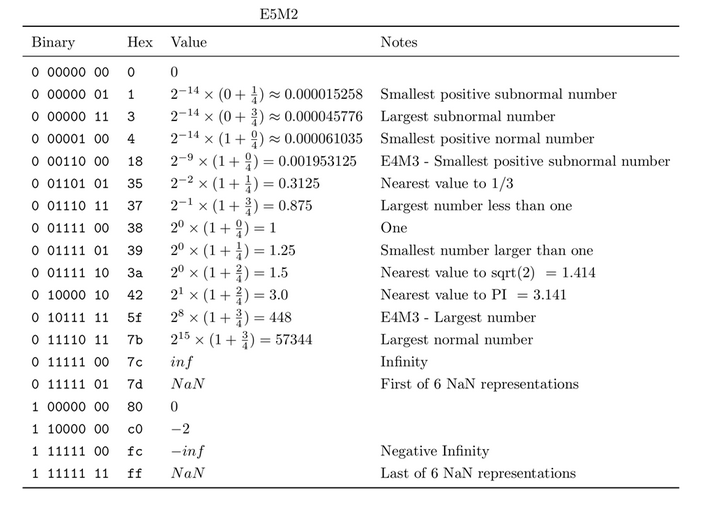
Table 3. Floating point numbers in E5M2 format
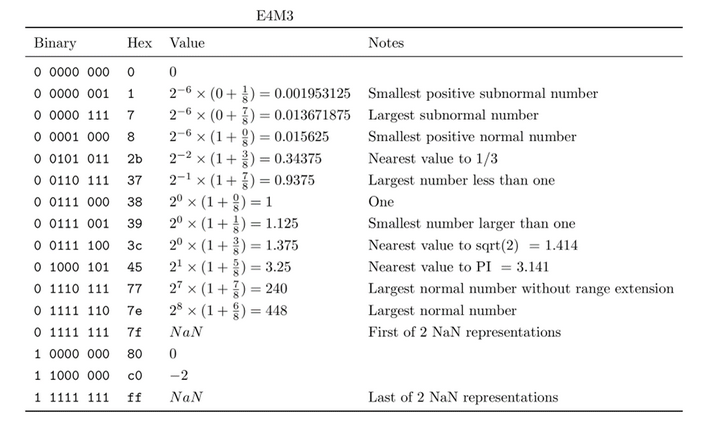
Table 4. Floating point numbers in E4M3 format
Comparison of the ranges of positive values of FP8_E4M3 and FP8_E5M2 numbers is shown in the figure 6.
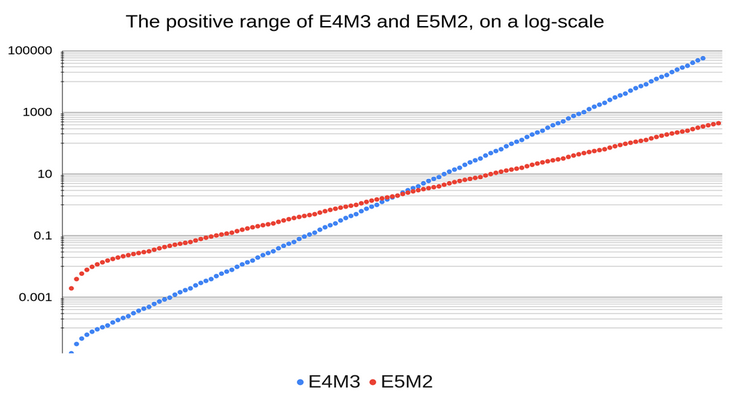
Fig.6. Comparison of the ranges for positive FP8 numbers (reference)
Comparison of the accuracy of arithmetic operations (Add, Mul, Div) for numbers in FP8_E5M2 and FP8_E4M3 formats is shown in the figure 7.

Fig.7. Comparison of the accuracy of arithmetic operations for numbers in the float8_e5m2 and float8_e4m3 formats (reference)
Recommended usage of numbers in the FP8 format:
- E4M3 for weight and activation tensors;
- E5M2 for gradient tensors.
1.2.2. Execution tests of the ONNX operator Cast for FLOAT8
This example considers the conversion from various types of FLOAT8 to float.
ONNX models with the Cast operation:
- https://github.com/onnx/onnx/tree/main/onnx/backend/test/data/node/test_cast_FLOAT8E4M3FN_to_FLOAT.onnx
- https://github.com/onnx/onnx/tree/main/onnx/backend/test/data/node/test_cast_FLOAT8E4M3FNUZ_to_FLOAT.onnx
- https://github.com/onnx/onnx/tree/main/onnx/backend/test/data/node/test_cast_FLOAT8E5M2_to_FLOAT.onnx
- https://github.com/onnx/onnx/tree/main/onnx/backend/test/data/node/test_cast_FLOAT8E5M2FNUZ_to_FLOAT.onnx
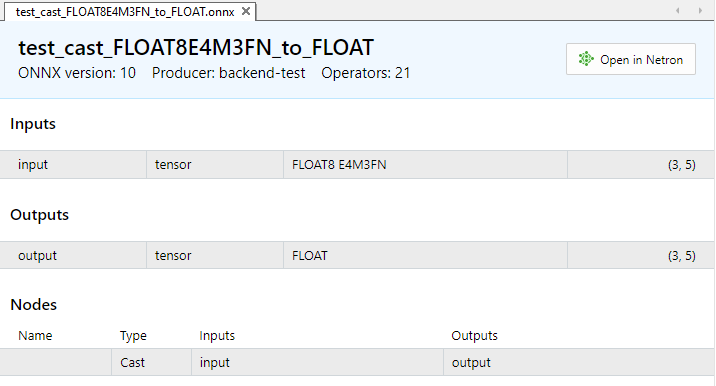
Fig.8. Input and output parameters of the model test_cast_FLOAT8E4M3FN_to_FLOAT.onnx in MetaEditor

Fig.9. Input and output parameters of the model test_cast_FLOAT8E4M3FNUZ_to_FLOAT.onnx in MetaEditor

Fig.10. Input and output parameters of the model test_cast_FLOAT8E5M2_to_FLOAT.onnx in MetaEditor
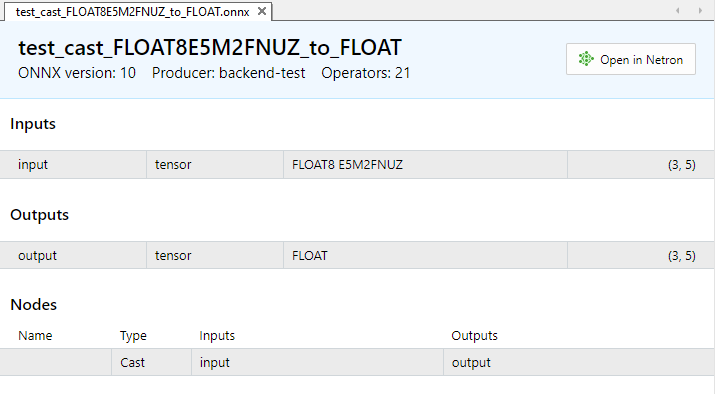
Fig.11. Input and output parameters of the model test_cast_FLOAT8E5M2FNUZ_to_FLOAT.onnx in MetaEditor
Example:
//+------------------------------------------------------------------+ //| TestCastBFloat8.mq5 | //| Copyright 2024, MetaQuotes Ltd. | //| https://www.mql5.com | //+------------------------------------------------------------------+ #property copyright "Copyright 2024, MetaQuotes Ltd." #property link "https://www.mql5.com" #property version "1.00" #resource "models\\test_cast_FLOAT8E4M3FN_to_FLOAT.onnx" as const uchar ExtModel_FLOAT8E4M3FN_to_FLOAT[]; #resource "models\\test_cast_FLOAT8E4M3FNUZ_to_FLOAT.onnx" as const uchar ExtModel_FLOAT8E4M3FNUZ_to_FLOAT[]; #resource "models\\test_cast_FLOAT8E5M2_to_FLOAT.onnx" as const uchar ExtModel_FLOAT8E5M2_to_FLOAT[]; #resource "models\\test_cast_FLOAT8E5M2FNUZ_to_FLOAT.onnx" as const uchar ExtModel_FLOAT8E5M2FNUZ_to_FLOAT[]; #define TEST_PASSED 0 #define TEST_FAILED 1 //+------------------------------------------------------------------+ //| union for data conversion | //+------------------------------------------------------------------+ template<typename T> union U { uchar uc[sizeof(T)]; T value; }; //+------------------------------------------------------------------+ //| ArrayToHexString | //+------------------------------------------------------------------+ template<typename T> string ArrayToHexString(const T &data[],uint length=16) { string res; for(uint n=0; n<MathMin(length,data.Size()); n++) res+="," + StringFormat("%.2x",data[n]); StringSetCharacter(res,0,'['); return(res+"]"); } //+------------------------------------------------------------------+ //| ArrayToString | //+------------------------------------------------------------------+ template<typename T> string ArrayToString(const U<T> &data[],uint length=16) { string res; for(uint n=0; n<MathMin(length,data.Size()); n++) res+="," + (string)data[n].value; StringSetCharacter(res,0,'['); return(res+"]"); } //+------------------------------------------------------------------+ //| PatchONNXModel | //+------------------------------------------------------------------+ long CreatePatchedModel(const uchar &original_model[]) { uchar patched_model[]; ArrayCopy(patched_model,original_model); //--- special ONNX model patch(IR=9,Opset=20) patched_model[1]=0x09; patched_model[ArraySize(patched_model)-1]=0x14; return(OnnxCreateFromBuffer(patched_model,ONNX_DEFAULT)); } //+------------------------------------------------------------------+ //| PrepareShapes | //+------------------------------------------------------------------+ bool PrepareShapes(long model_handle) { //--- configure input shape ulong input_shape[]= {3,5}; if(!OnnxSetInputShape(model_handle,0,input_shape)) { PrintFormat("error in OnnxSetInputShape for input1. error code=%d",GetLastError()); OnnxRelease(model_handle); return(false); } //--- configure output shape ulong output_shape[]= {3,5}; if(!OnnxSetOutputShape(model_handle,0,output_shape)) { PrintFormat("error in OnnxSetOutputShape for output. error code=%d",GetLastError()); OnnxRelease(model_handle); return(false); } return(true); } //+------------------------------------------------------------------+ //| RunCastFloat8Float | //+------------------------------------------------------------------+ bool RunCastFloat8ToFloat(long model_handle,const ENUM_FLOAT8_FORMAT fmt) { PrintFormat("TEST: %s(%s)",__FUNCTION__,EnumToString(fmt)); //--- float test_data[15] = {1,2,3,4,5,6,7,8,9,10,11,12,13,14,15}; uchar data_float8[15] = {}; if(!ArrayToFP8(data_float8,test_data,fmt)) { Print("error in ArrayToFP8. error code=",GetLastError()); OnnxRelease(model_handle); return(false); } U<uchar> input_float8_values[3*5]; U<float> output_float_values[3*5]; float test_data_float[]; //--- convert float8 to float if(!ArrayFromFP8(test_data_float,data_float8,fmt)) { Print("error in ArrayFromFP8. error code=",GetLastError()); OnnxRelease(model_handle); return(false); } for(uint i=0; i<data_float8.Size(); i++) { input_float8_values[i].value=data_float8[i]; PrintFormat("%d input value =%f Hex float8 = %s ushort value=%d",i,test_data_float[i],ArrayToHexString(input_float8_values[i].uc),input_float8_values[i].value); } Print("ONNX input array: ",ArrayToString(input_float8_values)); //--- execute model (convert float8 to float using ONNX) if(!OnnxRun(model_handle,ONNX_NO_CONVERSION,input_float8_values,output_float_values)) { PrintFormat("error in OnnxRun. error code=%d",GetLastError()); OnnxRelease(model_handle); return(false); } Print("ONNX output array: ",ArrayToString(output_float_values)); //--- calculate error (compare ONNX and ArrayFromFP8 results) double sum_error=0.0; for(uint i=0; i<test_data.Size(); i++) { double delta=test_data_float[i]-(double)output_float_values[i].value; sum_error+=MathAbs(delta); PrintFormat("%d output float %f = %s difference=%f",i,output_float_values[i].value,ArrayToHexString(output_float_values[i].uc),delta); } //--- PrintFormat("%s(%s): sum_error=%f\n",__FUNCTION__,EnumToString(fmt),sum_error); return(true); } //+------------------------------------------------------------------+ //| TestModel | //+------------------------------------------------------------------+ bool TestModel(const uchar &model[],const ENUM_FLOAT8_FORMAT fmt) { //--- create patched model long model_handle=CreatePatchedModel(model); if(model_handle==INVALID_HANDLE) return(false); //--- prepare input and output shapes if(!PrepareShapes(model_handle)) return(false); //--- run ONNX model if(!RunCastFloat8ToFloat(model_handle,fmt)) return(false); //--- release model handle OnnxRelease(model_handle); return(true); } //+------------------------------------------------------------------+ //| Script program start function | //+------------------------------------------------------------------+ int OnStart(void) { //--- run ONNX model if(!TestModel(ExtModel_FLOAT8E4M3FN_to_FLOAT,FLOAT_FP8_E4M3FN)) return(TEST_FAILED); //--- run ONNX model if(!TestModel(ExtModel_FLOAT8E4M3FNUZ_to_FLOAT,FLOAT_FP8_E4M3FNUZ)) return(TEST_FAILED); //--- run ONNX model if(!TestModel(ExtModel_FLOAT8E5M2_to_FLOAT,FLOAT_FP8_E5M2FN)) return(TEST_FAILED); //--- run ONNX model if(!TestModel(ExtModel_FLOAT8E5M2FNUZ_to_FLOAT,FLOAT_FP8_E5M2FNUZ)) return(TEST_FAILED); return(TEST_PASSED); } //+------------------------------------------------------------------+Output:
TestCastFloat8 (EURUSD,H1) TEST: RunCastFloat8ToFloat(FLOAT_FP8_E4M3FN) TestCastFloat8 (EURUSD,H1) 0 input value =1.000000 Hex float8 = [38] ushort value=56 TestCastFloat8 (EURUSD,H1) 1 input value =2.000000 Hex float8 = [40] ushort value=64 TestCastFloat8 (EURUSD,H1) 2 input value =3.000000 Hex float8 = [44] ushort value=68 TestCastFloat8 (EURUSD,H1) 3 input value =4.000000 Hex float8 = [48] ushort value=72 TestCastFloat8 (EURUSD,H1) 4 input value =5.000000 Hex float8 = [4a] ushort value=74 TestCastFloat8 (EURUSD,H1) 5 input value =6.000000 Hex float8 = [4c] ushort value=76 TestCastFloat8 (EURUSD,H1) 6 input value =7.000000 Hex float8 = [4e] ushort value=78 TestCastFloat8 (EURUSD,H1) 7 input value =8.000000 Hex float8 = [50] ushort value=80 TestCastFloat8 (EURUSD,H1) 8 input value =9.000000 Hex float8 = [51] ushort value=81 TestCastFloat8 (EURUSD,H1) 9 input value =10.000000 Hex float8 = [52] ushort value=82 TestCastFloat8 (EURUSD,H1) 10 input value =11.000000 Hex float8 = [53] ushort value=83 TestCastFloat8 (EURUSD,H1) 11 input value =12.000000 Hex float8 = [54] ushort value=84 TestCastFloat8 (EURUSD,H1) 12 input value =13.000000 Hex float8 = [55] ushort value=85 TestCastFloat8 (EURUSD,H1) 13 input value =14.000000 Hex float8 = [56] ushort value=86 TestCastFloat8 (EURUSD,H1) 14 input value =15.000000 Hex float8 = [57] ushort value=87 TestCastFloat8 (EURUSD,H1) ONNX input array: [56,64,68,72,74,76,78,80,81,82,83,84,85,86,87] TestCastFloat8 (EURUSD,H1) ONNX output array: [1.0,2.0,3.0,4.0,5.0,6.0,7.0,8.0,9.0,10.0,11.0,12.0,13.0,14.0,15.0] TestCastFloat8 (EURUSD,H1) 0 output float 1.000000 = [00,00,80,3f] difference=0.000000 TestCastFloat8 (EURUSD,H1) 1 output float 2.000000 = [00,00,00,40] difference=0.000000 TestCastFloat8 (EURUSD,H1) 2 output float 3.000000 = [00,00,40,40] difference=0.000000 TestCastFloat8 (EURUSD,H1) 3 output float 4.000000 = [00,00,80,40] difference=0.000000 TestCastFloat8 (EURUSD,H1) 4 output float 5.000000 = [00,00,a0,40] difference=0.000000 TestCastFloat8 (EURUSD,H1) 5 output float 6.000000 = [00,00,c0,40] difference=0.000000 TestCastFloat8 (EURUSD,H1) 6 output float 7.000000 = [00,00,e0,40] difference=0.000000 TestCastFloat8 (EURUSD,H1) 7 output float 8.000000 = [00,00,00,41] difference=0.000000 TestCastFloat8 (EURUSD,H1) 8 output float 9.000000 = [00,00,10,41] difference=0.000000 TestCastFloat8 (EURUSD,H1) 9 output float 10.000000 = [00,00,20,41] difference=0.000000 TestCastFloat8 (EURUSD,H1) 10 output float 11.000000 = [00,00,30,41] difference=0.000000 TestCastFloat8 (EURUSD,H1) 11 output float 12.000000 = [00,00,40,41] difference=0.000000 TestCastFloat8 (EURUSD,H1) 12 output float 13.000000 = [00,00,50,41] difference=0.000000 TestCastFloat8 (EURUSD,H1) 13 output float 14.000000 = [00,00,60,41] difference=0.000000 TestCastFloat8 (EURUSD,H1) 14 output float 15.000000 = [00,00,70,41] difference=0.000000 TestCastFloat8 (EURUSD,H1) RunCastFloat8ToFloat(FLOAT_FP8_E4M3FN): sum_error=0.000000 TestCastFloat8 (EURUSD,H1) TestCastFloat8 (EURUSD,H1) TEST: RunCastFloat8ToFloat(FLOAT_FP8_E4M3FNUZ) TestCastFloat8 (EURUSD,H1) 0 input value =1.000000 Hex float8 = [40] ushort value=64 TestCastFloat8 (EURUSD,H1) 1 input value =2.000000 Hex float8 = [48] ushort value=72 TestCastFloat8 (EURUSD,H1) 2 input value =3.000000 Hex float8 = [4c] ushort value=76 TestCastFloat8 (EURUSD,H1) 3 input value =4.000000 Hex float8 = [50] ushort value=80 TestCastFloat8 (EURUSD,H1) 4 input value =5.000000 Hex float8 = [52] ushort value=82 TestCastFloat8 (EURUSD,H1) 5 input value =6.000000 Hex float8 = [54] ushort value=84 TestCastFloat8 (EURUSD,H1) 6 input value =7.000000 Hex float8 = [56] ushort value=86 TestCastFloat8 (EURUSD,H1) 7 input value =8.000000 Hex float8 = [58] ushort value=88 TestCastFloat8 (EURUSD,H1) 8 input value =9.000000 Hex float8 = [59] ushort value=89 TestCastFloat8 (EURUSD,H1) 9 input value =10.000000 Hex float8 = [5a] ushort value=90 TestCastFloat8 (EURUSD,H1) 10 input value =11.000000 Hex float8 = [5b] ushort value=91 TestCastFloat8 (EURUSD,H1) 11 input value =12.000000 Hex float8 = [5c] ushort value=92 TestCastFloat8 (EURUSD,H1) 12 input value =13.000000 Hex float8 = [5d] ushort value=93 TestCastFloat8 (EURUSD,H1) 13 input value =14.000000 Hex float8 = [5e] ushort value=94 TestCastFloat8 (EURUSD,H1) 14 input value =15.000000 Hex float8 = [5f] ushort value=95 TestCastFloat8 (EURUSD,H1) ONNX input array: [64,72,76,80,82,84,86,88,89,90,91,92,93,94,95] TestCastFloat8 (EURUSD,H1) ONNX output array: [1.0,2.0,3.0,4.0,5.0,6.0,7.0,8.0,9.0,10.0,11.0,12.0,13.0,14.0,15.0] TestCastFloat8 (EURUSD,H1) 0 output float 1.000000 = [00,00,80,3f] difference=0.000000 TestCastFloat8 (EURUSD,H1) 1 output float 2.000000 = [00,00,00,40] difference=0.000000 TestCastFloat8 (EURUSD,H1) 2 output float 3.000000 = [00,00,40,40] difference=0.000000 TestCastFloat8 (EURUSD,H1) 3 output float 4.000000 = [00,00,80,40] difference=0.000000 TestCastFloat8 (EURUSD,H1) 4 output float 5.000000 = [00,00,a0,40] difference=0.000000 TestCastFloat8 (EURUSD,H1) 5 output float 6.000000 = [00,00,c0,40] difference=0.000000 TestCastFloat8 (EURUSD,H1) 6 output float 7.000000 = [00,00,e0,40] difference=0.000000 TestCastFloat8 (EURUSD,H1) 7 output float 8.000000 = [00,00,00,41] difference=0.000000 TestCastFloat8 (EURUSD,H1) 8 output float 9.000000 = [00,00,10,41] difference=0.000000 TestCastFloat8 (EURUSD,H1) 9 output float 10.000000 = [00,00,20,41] difference=0.000000 TestCastFloat8 (EURUSD,H1) 10 output float 11.000000 = [00,00,30,41] difference=0.000000 TestCastFloat8 (EURUSD,H1) 11 output float 12.000000 = [00,00,40,41] difference=0.000000 TestCastFloat8 (EURUSD,H1) 12 output float 13.000000 = [00,00,50,41] difference=0.000000 TestCastFloat8 (EURUSD,H1) 13 output float 14.000000 = [00,00,60,41] difference=0.000000 TestCastFloat8 (EURUSD,H1) 14 output float 15.000000 = [00,00,70,41] difference=0.000000 TestCastFloat8 (EURUSD,H1) RunCastFloat8ToFloat(FLOAT_FP8_E4M3FNUZ): sum_error=0.000000 TestCastFloat8 (EURUSD,H1) TestCastFloat8 (EURUSD,H1) TEST: RunCastFloat8ToFloat(FLOAT_FP8_E5M2FN) TestCastFloat8 (EURUSD,H1) 0 input value =1.000000 Hex float8 = [3c] ushort value=60 TestCastFloat8 (EURUSD,H1) 1 input value =2.000000 Hex float8 = [40] ushort value=64 TestCastFloat8 (EURUSD,H1) 2 input value =3.000000 Hex float8 = [42] ushort value=66 TestCastFloat8 (EURUSD,H1) 3 input value =4.000000 Hex float8 = [44] ushort value=68 TestCastFloat8 (EURUSD,H1) 4 input value =5.000000 Hex float8 = [45] ushort value=69 TestCastFloat8 (EURUSD,H1) 5 input value =6.000000 Hex float8 = [46] ushort value=70 TestCastFloat8 (EURUSD,H1) 6 input value =7.000000 Hex float8 = [47] ushort value=71 TestCastFloat8 (EURUSD,H1) 7 input value =8.000000 Hex float8 = [48] ushort value=72 TestCastFloat8 (EURUSD,H1) 8 input value =8.000000 Hex float8 = [48] ushort value=72 TestCastFloat8 (EURUSD,H1) 9 input value =10.000000 Hex float8 = [49] ushort value=73 TestCastFloat8 (EURUSD,H1) 10 input value =12.000000 Hex float8 = [4a] ushort value=74 TestCastFloat8 (EURUSD,H1) 11 input value =12.000000 Hex float8 = [4a] ushort value=74 TestCastFloat8 (EURUSD,H1) 12 input value =12.000000 Hex float8 = [4a] ushort value=74 TestCastFloat8 (EURUSD,H1) 13 input value =14.000000 Hex float8 = [4b] ushort value=75 TestCastFloat8 (EURUSD,H1) 14 input value =16.000000 Hex float8 = [4c] ushort value=76 TestCastFloat8 (EURUSD,H1) ONNX input array: [60,64,66,68,69,70,71,72,72,73,74,74,74,75,76] TestCastFloat8 (EURUSD,H1) ONNX output array: [1.0,2.0,3.0,4.0,5.0,6.0,7.0,8.0,8.0,10.0,12.0,12.0,12.0,14.0,16.0] TestCastFloat8 (EURUSD,H1) 0 output float 1.000000 = [00,00,80,3f] difference=0.000000 TestCastFloat8 (EURUSD,H1) 1 output float 2.000000 = [00,00,00,40] difference=0.000000 TestCastFloat8 (EURUSD,H1) 2 output float 3.000000 = [00,00,40,40] difference=0.000000 TestCastFloat8 (EURUSD,H1) 3 output float 4.000000 = [00,00,80,40] difference=0.000000 TestCastFloat8 (EURUSD,H1) 4 output float 5.000000 = [00,00,a0,40] difference=0.000000 TestCastFloat8 (EURUSD,H1) 5 output float 6.000000 = [00,00,c0,40] difference=0.000000 TestCastFloat8 (EURUSD,H1) 6 output float 7.000000 = [00,00,e0,40] difference=0.000000 TestCastFloat8 (EURUSD,H1) 7 output float 8.000000 = [00,00,00,41] difference=0.000000 TestCastFloat8 (EURUSD,H1) 8 output float 8.000000 = [00,00,00,41] difference=0.000000 TestCastFloat8 (EURUSD,H1) 9 output float 10.000000 = [00,00,20,41] difference=0.000000 TestCastFloat8 (EURUSD,H1) 10 output float 12.000000 = [00,00,40,41] difference=0.000000 TestCastFloat8 (EURUSD,H1) 11 output float 12.000000 = [00,00,40,41] difference=0.000000 TestCastFloat8 (EURUSD,H1) 12 output float 12.000000 = [00,00,40,41] difference=0.000000 TestCastFloat8 (EURUSD,H1) 13 output float 14.000000 = [00,00,60,41] difference=0.000000 TestCastFloat8 (EURUSD,H1) 14 output float 16.000000 = [00,00,80,41] difference=0.000000 TestCastFloat8 (EURUSD,H1) RunCastFloat8ToFloat(FLOAT_FP8_E5M2FN): sum_error=0.000000 TestCastFloat8 (EURUSD,H1) TestCastFloat8 (EURUSD,H1) TEST: RunCastFloat8ToFloat(FLOAT_FP8_E5M2FNUZ) TestCastFloat8 (EURUSD,H1) 0 input value =1.000000 Hex float8 = [40] ushort value=64 TestCastFloat8 (EURUSD,H1) 1 input value =2.000000 Hex float8 = [44] ushort value=68 TestCastFloat8 (EURUSD,H1) 2 input value =3.000000 Hex float8 = [46] ushort value=70 TestCastFloat8 (EURUSD,H1) 3 input value =4.000000 Hex float8 = [48] ushort value=72 TestCastFloat8 (EURUSD,H1) 4 input value =5.000000 Hex float8 = [49] ushort value=73 TestCastFloat8 (EURUSD,H1) 5 input value =6.000000 Hex float8 = [4a] ushort value=74 TestCastFloat8 (EURUSD,H1) 6 input value =7.000000 Hex float8 = [4b] ushort value=75 TestCastFloat8 (EURUSD,H1) 7 input value =8.000000 Hex float8 = [4c] ushort value=76 TestCastFloat8 (EURUSD,H1) 8 input value =8.000000 Hex float8 = [4c] ushort value=76 TestCastFloat8 (EURUSD,H1) 9 input value =10.000000 Hex float8 = [4d] ushort value=77 TestCastFloat8 (EURUSD,H1) 10 input value =12.000000 Hex float8 = [4e] ushort value=78 TestCastFloat8 (EURUSD,H1) 11 input value =12.000000 Hex float8 = [4e] ushort value=78 TestCastFloat8 (EURUSD,H1) 12 input value =12.000000 Hex float8 = [4e] ushort value=78 TestCastFloat8 (EURUSD,H1) 13 input value =14.000000 Hex float8 = [4f] ushort value=79 TestCastFloat8 (EURUSD,H1) 14 input value =16.000000 Hex float8 = [50] ushort value=80 TestCastFloat8 (EURUSD,H1) ONNX input array: [64,68,70,72,73,74,75,76,76,77,78,78,78,79,80] TestCastFloat8 (EURUSD,H1) ONNX output array: [1.0,2.0,3.0,4.0,5.0,6.0,7.0,8.0,8.0,10.0,12.0,12.0,12.0,14.0,16.0] TestCastFloat8 (EURUSD,H1) 0 output float 1.000000 = [00,00,80,3f] difference=0.000000 TestCastFloat8 (EURUSD,H1) 1 output float 2.000000 = [00,00,00,40] difference=0.000000 TestCastFloat8 (EURUSD,H1) 2 output float 3.000000 = [00,00,40,40] difference=0.000000 TestCastFloat8 (EURUSD,H1) 3 output float 4.000000 = [00,00,80,40] difference=0.000000 TestCastFloat8 (EURUSD,H1) 4 output float 5.000000 = [00,00,a0,40] difference=0.000000 TestCastFloat8 (EURUSD,H1) 5 output float 6.000000 = [00,00,c0,40] difference=0.000000 TestCastFloat8 (EURUSD,H1) 6 output float 7.000000 = [00,00,e0,40] difference=0.000000 TestCastFloat8 (EURUSD,H1) 7 output float 8.000000 = [00,00,00,41] difference=0.000000 TestCastFloat8 (EURUSD,H1) 8 output float 8.000000 = [00,00,00,41] difference=0.000000 TestCastFloat8 (EURUSD,H1) 9 output float 10.000000 = [00,00,20,41] difference=0.000000 TestCastFloat8 (EURUSD,H1) 10 output float 12.000000 = [00,00,40,41] difference=0.000000 TestCastFloat8 (EURUSD,H1) 11 output float 12.000000 = [00,00,40,41] difference=0.000000 TestCastFloat8 (EURUSD,H1) 12 output float 12.000000 = [00,00,40,41] difference=0.000000 TestCastFloat8 (EURUSD,H1) 13 output float 14.000000 = [00,00,60,41] difference=0.000000 TestCastFloat8 (EURUSD,H1) 14 output float 16.000000 = [00,00,80,41] difference=0.000000 TestCastFloat8 (EURUSD,H1) RunCastFloat8ToFloat(FLOAT_FP8_E5M2FNUZ): sum_error=0.000000 TestCastFloat8 (EURUSD,H1)
2. Using ONNX for Image Super-Resolution
In this section, we will explore an example of using SRGAN models for enhancing image resolution.
ESRGAN, or Enhanced Super-Resolution Generative Adversarial Networks, is a powerful neural network architecture designed to address the task of image super-resolution. ESRGAN is developed to enhance image quality by increasing their resolution to a higher level. This is achieved by training a deep neural network on a large dataset of low-resolution images and their corresponding high-quality images. ESRGAN employs the architecture of Generative Adversarial Networks (GANs), which consists of two main components: a generator and a discriminator. The generator is responsible for creating high-resolution images, while the discriminator is trained to distinguish between the generated images and real ones.
At the core of the ESRGAN architecture are residual blocks, which help extract and preserve important image features at different levels of abstraction. This enables the network to efficiently restore details and textures in high-quality images.
To achieve high quality and universality in solving the super-resolution task, ESRGAN requires extensive training datasets. This allows the network to learn various styles and characteristics of images, making it more adaptable to different types of input data. ESRGAN can be used to improve image quality in many fields, including photography, medical diagnostics, film and video production, graphic design, and more. Its flexibility and efficiency make it one of the leading methods in the field of image super-resolution.
ESRGAN represents a significant advancement in the field of image processing and artificial intelligence, opening up new possibilities for creating and enhancing images.
2.1. Executing an ONNX Model with float32
To execute the example, you need to download the file https://github.com/amannm/super-resolution-service/blob/main/models/esrgan.onnx and copy it to the folder \MQL5\Scripts\models.
The ESRGAN.onnx model contains ~1200 ONNX operations, the initial ones of which are presented in Fig.12.

Fig.12. ESRGAN.onnx model description in MetaEditor
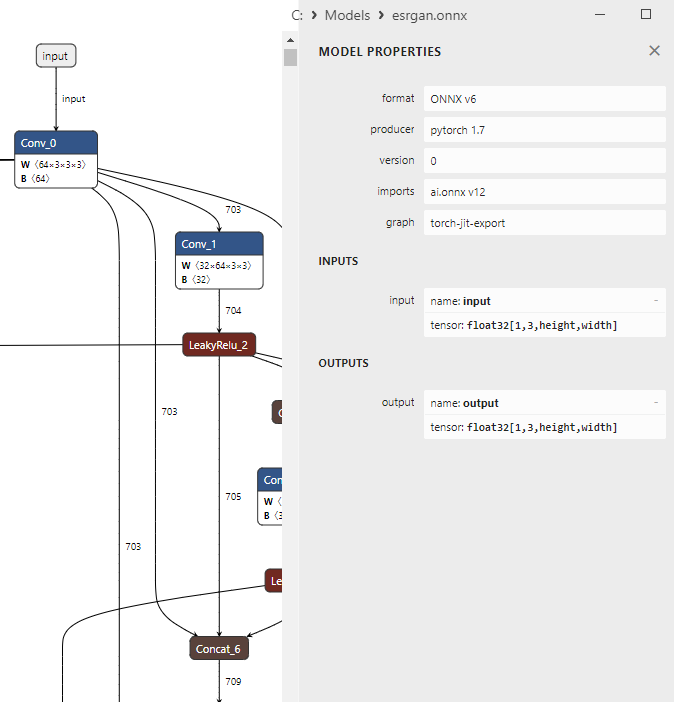
Fig.13. ESRGAN.ONNX model in Netron
It starts by loading the esrgan.onnx model, then selecting and loading the original image in BMP format. After that, the image is converted into separate RGB channels, which are then fed into the model as input. The model performs the process of upscaling the image by a factor of 4, after which the resulting upscaled image undergoes inverse transformation and is prepared for display.
The Canvas library is used for display, and the ONNX Runtime library is used for model execution. Upon program execution, the upscaled image is saved to a file with "_upscaled" appended to the original file name. Key functions include image preprocessing and postprocessing, as well as model execution for image upscaling.
//+------------------------------------------------------------------+ //| ESRGAN.mq5 | //| Copyright 2024, MetaQuotes Ltd. | //| https://www.mql5.com | //+------------------------------------------------------------------+ #property copyright "Copyright 2024, MetaQuotes Ltd." #property link "https://www.mql5.com" #property version "1.00" //+------------------------------------------------------------------+ //| 4x image upscaling demo using ESRGAN | //| esrgan.onnx model from | //| https://github.com/amannm/super-resolution-service/ | //+------------------------------------------------------------------+ //| Xintao Wang et al (2018) | //| ESRGAN: Enhanced Super-Resolution Generative Adversarial Networks| //| https://arxiv.org/abs/1809.00219 | //+------------------------------------------------------------------+ #resource "models\\esrgan.onnx" as uchar ExtModel[]; #include <Canvas\Canvas.mqh> //+------------------------------------------------------------------+ //| clamp | //+------------------------------------------------------------------+ float clamp(float value, float minValue, float maxValue) { return MathMin(MathMax(value, minValue), maxValue); } //+------------------------------------------------------------------+ //| Preprocessing | //+------------------------------------------------------------------+ bool Preprocessing(float &data[],uint &image_data[],int &image_width,int &image_height) { //--- checkup if(image_height==0 || image_width==0) return(false); //--- prepare destination array with separated RGB channels for ONNX model int data_count=3*image_width*image_height; if(ArrayResize(data,data_count)!=data_count) { Print("ArrayResize failed"); return(false); } //--- converting for(int y=0; y<image_height; y++) for(int x=0; x<image_width; x++) { //--- load source RGB int offset=y*image_width+x; uint clr =image_data[offset]; uchar r =GETRGBR(clr); uchar g =GETRGBG(clr); uchar b =GETRGBB(clr); //--- store RGB components as separated channels int offset_ch1=0*image_width*image_height+offset; int offset_ch2=1*image_width*image_height+offset; int offset_ch3=2*image_width*image_height+offset; data[offset_ch1]=r/255.0f; data[offset_ch2]=g/255.0f; data[offset_ch3]=b/255.0f; } //--- return(true); } //+------------------------------------------------------------------+ //| PostProcessing | //+------------------------------------------------------------------+ bool PostProcessing(const float &data[], uint &image_data[], const int &image_width, const int &image_height) { //--- checks if(image_height == 0 || image_width == 0) return(false); int data_count=image_width*image_height; if(ArraySize(data)!=3*data_count) return(false); if(ArrayResize(image_data,data_count)!=data_count) return(false); //--- for(int y=0; y<image_height; y++) for(int x=0; x<image_width; x++) { int offset =y*image_width+x; int offset_ch1=0*image_width*image_height+offset; int offset_ch2=1*image_width*image_height+offset; int offset_ch3=2*image_width*image_height+offset; //--- rescale to [0..255] float r=clamp(data[offset_ch1]*255,0,255); float g=clamp(data[offset_ch2]*255,0,255); float b=clamp(data[offset_ch3]*255,0,255); //--- set color image_data image_data[offset]=XRGB(uchar(r),uchar(g),uchar(b)); } //--- return(true); } //+------------------------------------------------------------------+ //| ShowImage | //+------------------------------------------------------------------+ bool ShowImage(CCanvas &canvas,const string name,const int x0,const int y0,const int image_width,const int image_height, const uint &image_data[]) { if(ArraySize(image_data)==0 || name=="") return(false); //--- prepare canvas canvas.CreateBitmapLabel(name,x0,y0,image_width,image_height,COLOR_FORMAT_XRGB_NOALPHA); //--- copy image to canvas for(int y=0; y<image_height; y++) for(int x=0; x<image_width; x++) canvas.PixelSet(x,y,image_data[y*image_width+x]); //--- ready to draw canvas.Update(true); return(true); } //+------------------------------------------------------------------+ //| Script program start function | //+------------------------------------------------------------------+ int OnStart(void) { //--- select BMP from <data folder>\MQL5\Files string image_path[1]; if(FileSelectDialog("Select BMP image",NULL,"Bitmap files (*.bmp)|*.bmp",FSD_FILE_MUST_EXIST,image_path,"lenna-original4.bmp")!=1) { Print("file not selected"); return(-1); } //--- load BMP into array uint image_data[]; int image_width; int image_height; if(!CCanvas::LoadBitmap(image_path[0],image_data,image_width,image_height)) { PrintFormat("CCanvas::LoadBitmap failed with error %d",GetLastError()); return(-1); } //--- convert RGB image to separated RGB channels float input_data[]; Preprocessing(input_data,image_data,image_width,image_height); PrintFormat("input array size=%d",ArraySize(input_data)); //--- load model long model_handle=OnnxCreateFromBuffer(ExtModel,ONNX_DEFAULT); if(model_handle==INVALID_HANDLE) { PrintFormat("OnnxCreate error %d",GetLastError()); return(-1); } PrintFormat("model loaded successfully"); PrintFormat("original: width=%d, height=%d Size=%d",image_width,image_height,ArraySize(image_data)); //--- set input shape ulong input_shape[]={1,3,image_height,image_width}; if(!OnnxSetInputShape(model_handle,0,input_shape)) { PrintFormat("error in OnnxSetInputShape. error code=%d",GetLastError()); OnnxRelease(model_handle); return(-1); } //--- upscaled image size int new_image_width =4*image_width; int new_image_height=4*image_height; ulong output_shape[]= {1,3,new_image_height,new_image_width}; if(!OnnxSetOutputShape(model_handle,0,output_shape)) { PrintFormat("error in OnnxSetOutputShape. error code=%d",GetLastError()); OnnxRelease(model_handle); return(-1); } //--- run the model float output_data[]; int new_data_count=3*new_image_width*new_image_height; if(ArrayResize(output_data,new_data_count)!=new_data_count) { OnnxRelease(model_handle); return(-1); } if(!OnnxRun(model_handle,ONNX_DEBUG_LOGS,input_data,output_data)) { PrintFormat("error in OnnxRun. error code=%d",GetLastError()); OnnxRelease(model_handle); return(-1); } Print("model successfully executed, output data size ",ArraySize(output_data)); OnnxRelease(model_handle); //--- postprocessing uint new_image[]; PostProcessing(output_data,new_image,new_image_width,new_image_height); //--- show images CCanvas canvas_original,canvas_scaled; ShowImage(canvas_original,"original_image",new_image_width,0,image_width,image_height,image_data); ShowImage(canvas_scaled,"upscaled_image",0,0,new_image_width,new_image_height,new_image); //--- save upscaled image StringReplace(image_path[0],".bmp","_upscaled.bmp"); Print(ResourceSave(canvas_scaled.ResourceName(),image_path[0])); //--- while(!IsStopped()) Sleep(100); return(0); } //+------------------------------------------------------------------+
Output:
Fig.14. The result of the ESRGAN.onnx model execution (160x200 -> 640x800)
In this example, the 160x200 image was enlarged four times (to 640x800) using the ESRGAN.onnx model.
2.2. Example of executing an ONNX model with float16
To convert models to float16, we will use the method described in Create Float16 and Mixed Precision Models.
# Copyright 2024, MetaQuotes Ltd. # https://www.mql5.com import onnx from onnxconverter_common import float16 from sys import argv # Define the path for saving the model data_path = argv[0] last_index = data_path.rfind("\\") + 1 data_path = data_path[0:last_index] # convert the model to float16 model_path = data_path+'\\models\\esrgan.onnx' modelfp16_path = data_path+'\\models\\esrgan_float16.onnx' model = onnx.load(model_path) model_fp16 = float16.convert_float_to_float16(model) onnx.save(model_fp16, modelfp16_path)
After conversion, the file size decreased by half (from 64MB to 32MB).
The changes in the code are minimal.
//+------------------------------------------------------------------+ //| ESRGAN_float16.mq5 | //| Copyright 2024, MetaQuotes Ltd. | //| https://www.mql5.com | //+------------------------------------------------------------------+ #property copyright "Copyright 2024, MetaQuotes Ltd." #property link "https://www.mql5.com" #property version "1.00" //+------------------------------------------------------------------+ //| 4x image upscaling demo using ESRGAN | //| esrgan.onnx model from | //| https://github.com/amannm/super-resolution-service/ | //+------------------------------------------------------------------+ //| Xintao Wang et al (2018) | //| ESRGAN: Enhanced Super-Resolution Generative Adversarial Networks| //| https://arxiv.org/abs/1809.00219 | //+------------------------------------------------------------------+ #resource "models\\esrgan_float16.onnx" as uchar ExtModel[]; #include <Canvas\Canvas.mqh> //+------------------------------------------------------------------+ //| clamp | //+------------------------------------------------------------------+ float clamp(float value, float minValue, float maxValue) { return MathMin(MathMax(value, minValue), maxValue); } //+------------------------------------------------------------------+ //| Preprocessing | //+------------------------------------------------------------------+ bool Preprocessing(float &data[],uint &image_data[],int &image_width,int &image_height) { //--- checkup if(image_height==0 || image_width==0) return(false); //--- prepare destination array with separated RGB channels for ONNX model int data_count=3*image_width*image_height; if(ArrayResize(data,data_count)!=data_count) { Print("ArrayResize failed"); return(false); } //--- converting for(int y=0; y<image_height; y++) for(int x=0; x<image_width; x++) { //--- load source RGB int offset=y*image_width+x; uint clr =image_data[offset]; uchar r =GETRGBR(clr); uchar g =GETRGBG(clr); uchar b =GETRGBB(clr); //--- store RGB components as separated channels int offset_ch1=0*image_width*image_height+offset; int offset_ch2=1*image_width*image_height+offset; int offset_ch3=2*image_width*image_height+offset; data[offset_ch1]=r/255.0f; data[offset_ch2]=g/255.0f; data[offset_ch3]=b/255.0f; } //--- return(true); } //+------------------------------------------------------------------+ //| PostProcessing | //+------------------------------------------------------------------+ bool PostProcessing(const float &data[], uint &image_data[], const int &image_width, const int &image_height) { //--- checks if(image_height == 0 || image_width == 0) return(false); int data_count=image_width*image_height; if(ArraySize(data)!=3*data_count) return(false); if(ArrayResize(image_data,data_count)!=data_count) return(false); //--- for(int y=0; y<image_height; y++) for(int x=0; x<image_width; x++) { int offset =y*image_width+x; int offset_ch1=0*image_width*image_height+offset; int offset_ch2=1*image_width*image_height+offset; int offset_ch3=2*image_width*image_height+offset; //--- rescale to [0..255] float r=clamp(data[offset_ch1]*255,0,255); float g=clamp(data[offset_ch2]*255,0,255); float b=clamp(data[offset_ch3]*255,0,255); //--- set color image_data image_data[offset]=XRGB(uchar(r),uchar(g),uchar(b)); } //--- return(true); } //+------------------------------------------------------------------+ //| ShowImage | //+------------------------------------------------------------------+ bool ShowImage(CCanvas &canvas,const string name,const int x0,const int y0,const int image_width,const int image_height, const uint &image_data[]) { if(ArraySize(image_data)==0 || name=="") return(false); //--- prepare canvas canvas.CreateBitmapLabel(name,x0,y0,image_width,image_height,COLOR_FORMAT_XRGB_NOALPHA); //--- copy image to canvas for(int y=0; y<image_height; y++) for(int x=0; x<image_width; x++) canvas.PixelSet(x,y,image_data[y*image_width+x]); //--- ready to draw canvas.Update(true); return(true); } //+------------------------------------------------------------------+ //| Script program start function | //+------------------------------------------------------------------+ int OnStart(void) { //--- select BMP from <data folder>\MQL5\Files string image_path[1]; if(FileSelectDialog("Select BMP image",NULL,"Bitmap files (*.bmp)|*.bmp",FSD_FILE_MUST_EXIST,image_path,"lenna.bmp")!=1) { Print("file not selected"); return(-1); } //--- load BMP into array uint image_data[]; int image_width; int image_height; if(!CCanvas::LoadBitmap(image_path[0],image_data,image_width,image_height)) { PrintFormat("CCanvas::LoadBitmap failed with error %d",GetLastError()); return(-1); } //--- convert RGB image to separated RGB channels float input_data[]; Preprocessing(input_data,image_data,image_width,image_height); PrintFormat("input array size=%d",ArraySize(input_data)); ushort input_data_float16[]; if(!ArrayToFP16(input_data_float16,input_data,FLOAT_FP16)) { Print("error in ArrayToFP16. error code=",GetLastError()); return(false); } //--- load model long model_handle=OnnxCreateFromBuffer(ExtModel,ONNX_DEFAULT); if(model_handle==INVALID_HANDLE) { PrintFormat("OnnxCreate error %d",GetLastError()); return(-1); } PrintFormat("model loaded successfully"); PrintFormat("original: width=%d, height=%d Size=%d",image_width,image_height,ArraySize(image_data)); //--- set input shape ulong input_shape[]={1,3,image_height,image_width}; if(!OnnxSetInputShape(model_handle,0,input_shape)) { PrintFormat("error in OnnxSetInputShape. error code=%d",GetLastError()); OnnxRelease(model_handle); return(-1); } //--- upscaled image size int new_image_width =4*image_width; int new_image_height=4*image_height; ulong output_shape[]= {1,3,new_image_height,new_image_width}; if(!OnnxSetOutputShape(model_handle,0,output_shape)) { PrintFormat("error in OnnxSetOutputShape. error code=%d",GetLastError()); OnnxRelease(model_handle); return(-1); } //--- run the model float output_data[]; ushort output_data_float16[]; int new_data_count=3*new_image_width*new_image_height; if(ArrayResize(output_data_float16,new_data_count)!=new_data_count) { OnnxRelease(model_handle); return(-1); } if(!OnnxRun(model_handle,ONNX_NO_CONVERSION,input_data_float16,output_data_float16)) { PrintFormat("error in OnnxRun. error code=%d",GetLastError()); OnnxRelease(model_handle); return(-1); } Print("model successfully executed, output data size ",ArraySize(output_data)); OnnxRelease(model_handle); if(!ArrayFromFP16(output_data,output_data_float16,FLOAT_FP16)) { Print("error in ArrayFromFP16. error code=",GetLastError()); return(false); } //--- postprocessing uint new_image[]; PostProcessing(output_data,new_image,new_image_width,new_image_height); //--- show images CCanvas canvas_original,canvas_scaled; ShowImage(canvas_original,"original_image",new_image_width,0,image_width,image_height,image_data); ShowImage(canvas_scaled,"upscaled_image",0,0,new_image_width,new_image_height,new_image); //--- save upscaled image StringReplace(image_path[0],".bmp","_upscaled.bmp"); Print(ResourceSave(canvas_scaled.ResourceName(),image_path[0])); //--- while(!IsStopped()) Sleep(100); return(0); } //+------------------------------------------------------------------+
Changes in the code required to execute the model converted to float16 format are highlighted in color.
Output:

Fig.15. The result of the ESRGAN_float16.onnx model execution (160x200 -> 640x800)
Thus, using float16 numbers instead of float32 allows reducing the size of the ONNX model file by half (from 64MB to 32MB).
When executing models with float16 numbers, the image quality remained the same, making it visually difficult to find differences:
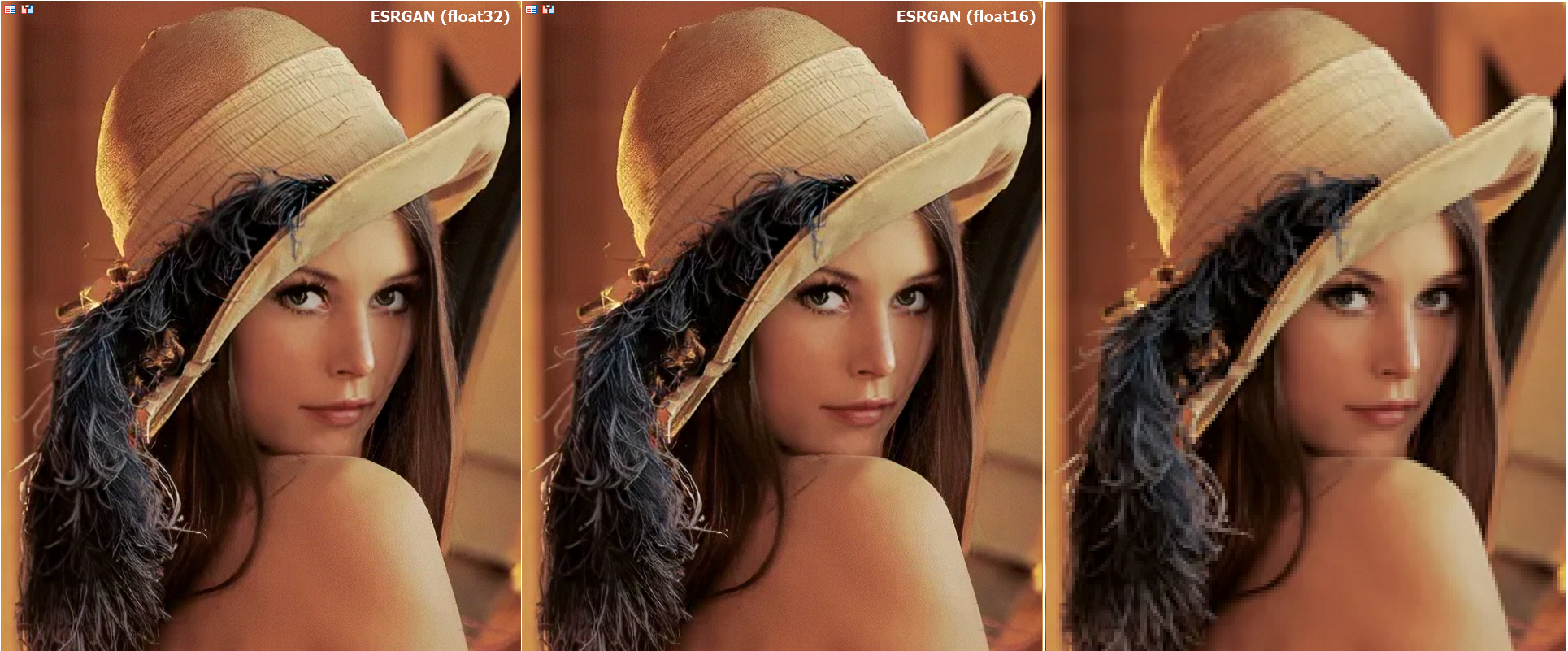
Fig.16. Comparison of the results of ESRGAN model operation for float and float16
The changes in the code are minimal, requiring only attention to the conversion of input and output data.
In this case, after conversion to float16, the model's performance quality did not change significantly. However, when analyzing financial data, it is essential to strive for calculations with the highest possible accuracy.
Conclusions
The use of new data types for floating-point numbers allows reducing the size of ONNX models without significant loss of quality.
Preprocessing and post-processing of data are significantly simplified by using conversion functions ArrayToFP16/ArrayFromFP16 and ArrayToFP8/ArrayFromFP8.
Minimal changes in the code are required to work with converted ONNX models.
Translated from Russian by MetaQuotes Ltd.
Original article: https://www.mql5.com/ru/articles/14330
Warning: All rights to these materials are reserved by MetaQuotes Ltd. Copying or reprinting of these materials in whole or in part is prohibited.
 Quantization in machine learning (Part 1): Theory, sample code, analysis of implementation in CatBoost
Quantization in machine learning (Part 1): Theory, sample code, analysis of implementation in CatBoost
 Experiments with neural networks (Part 7): Passing indicators
Experiments with neural networks (Part 7): Passing indicators
 Creating multi-symbol, multi-period indicators
Creating multi-symbol, multi-period indicators
 Neural networks made easy (Part 60): Online Decision Transformer (ODT)
Neural networks made easy (Part 60): Online Decision Transformer (ODT)
- Free trading apps
- Over 8,000 signals for copying
- Economic news for exploring financial markets
You agree to website policy and terms of use
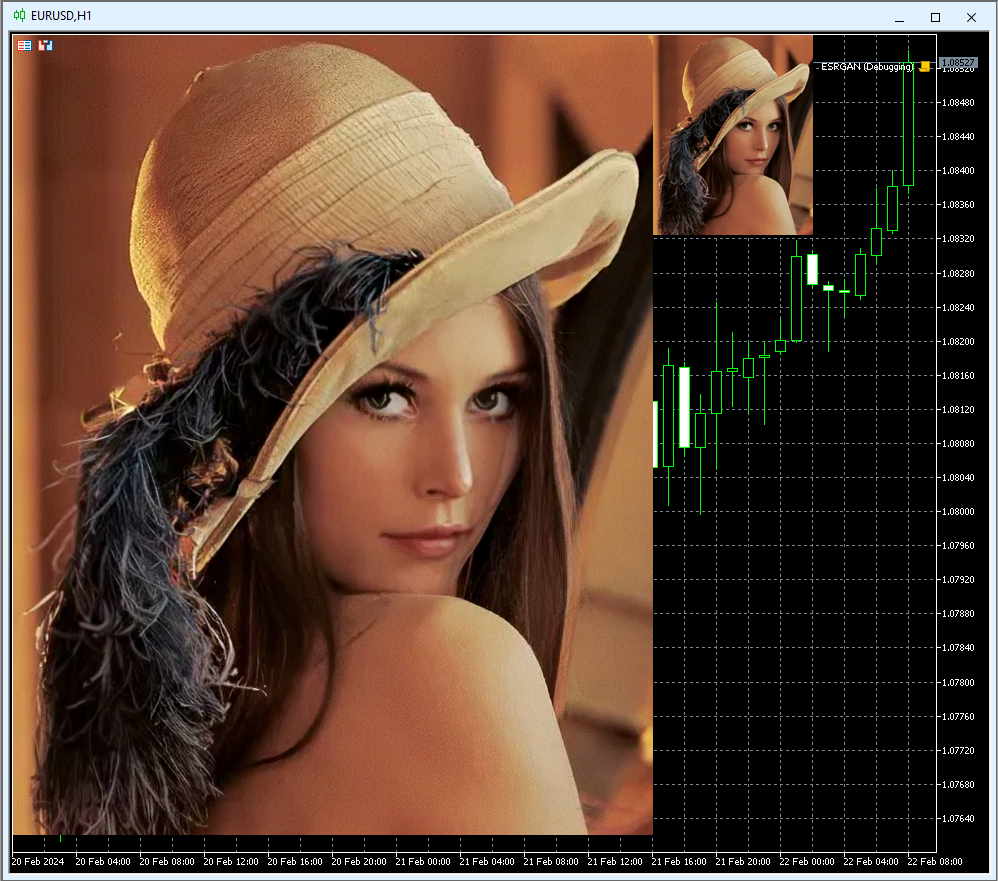
Please add another image of the same size on the right - a quadrupled (instead of one pixel - four (2x2) of the same colour) original image.
You can replace the code to display it:
You can replace the code to output it:
Thanks! Reduced by a factor of two at each coordinate, getting the right image as the original.
I thought that float16/32 would become close to the original with this transformation. But they are noticeably better! I.e. UpScale+DownScale >> Original.
ZY Surprised. It seems reasonable to run all old images/videos through such onnx-model.
If the onnx-model input is given the same data, will the output always be the same?
Is there an element of randomness within the onnx-model?
If the onnx model is fed the same data as input, but the output will always have the same result?
Is there an element of randomness within the onnx-model?
In general, it depends on what operators are used inside the ONNX model.
For this model the result should be the same, it contains deterministic operations (1195 in total)
Описание float16
https://ru.wikipedia.org/wiki/%D0%A7%D0%B8%D1%81%D0%BB%D0%BE_%D0%BF%D0%BE%D0%BB%D0%BE%D0%B2%D0%B8%D0%BD%D0%BD%D0%BE%D0%B9_%D1%82%D0%BE%D1%87%D0%BD%D0%BE%D1%81%D1%82%D0%B8
Примеры чисел половинной точности
In these examples, floating point numbers are represented in binary. They include the sign bit, exponent, and mantissa.
0 01111 0000000000 = +1 *215-15 = 1
0 01111 0000000001 = +1.0000000001 2 *215-15=1+ 2-10 = 1.0009765625 (the next higher number after 1)
I.e. for numbers with 5 decimal places (most currencies) only 1.00098 can be applied after 1.00000.
Cool! But not for trading and working with quotes.